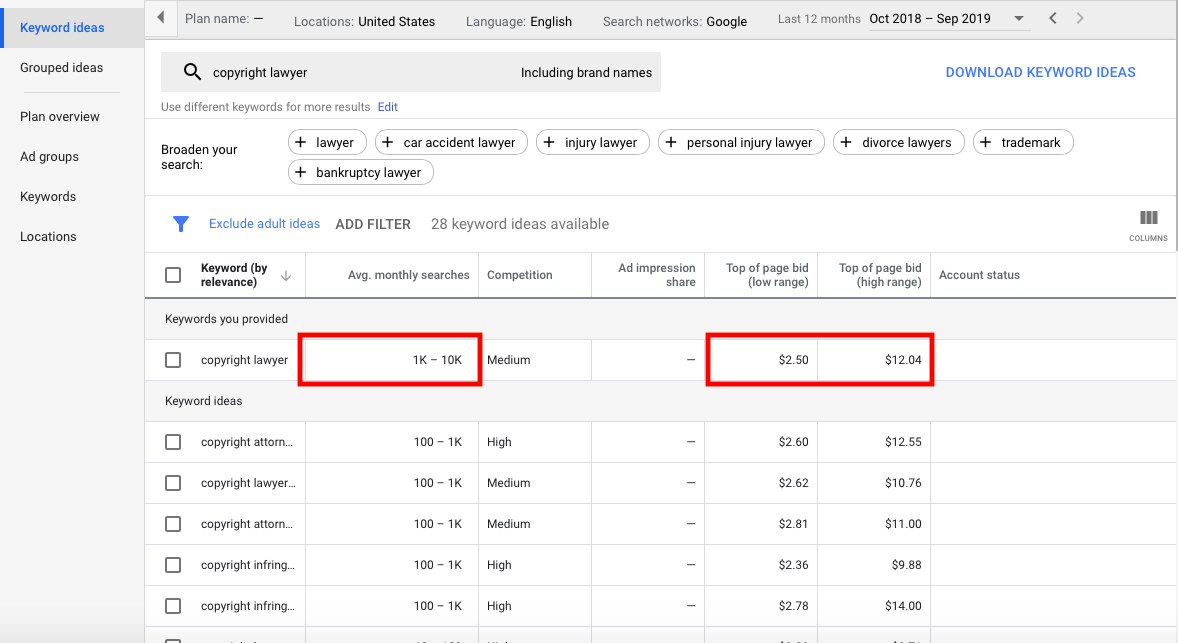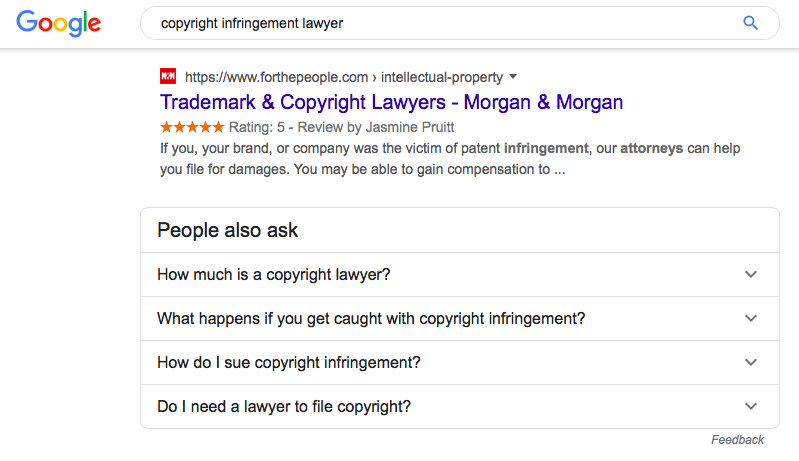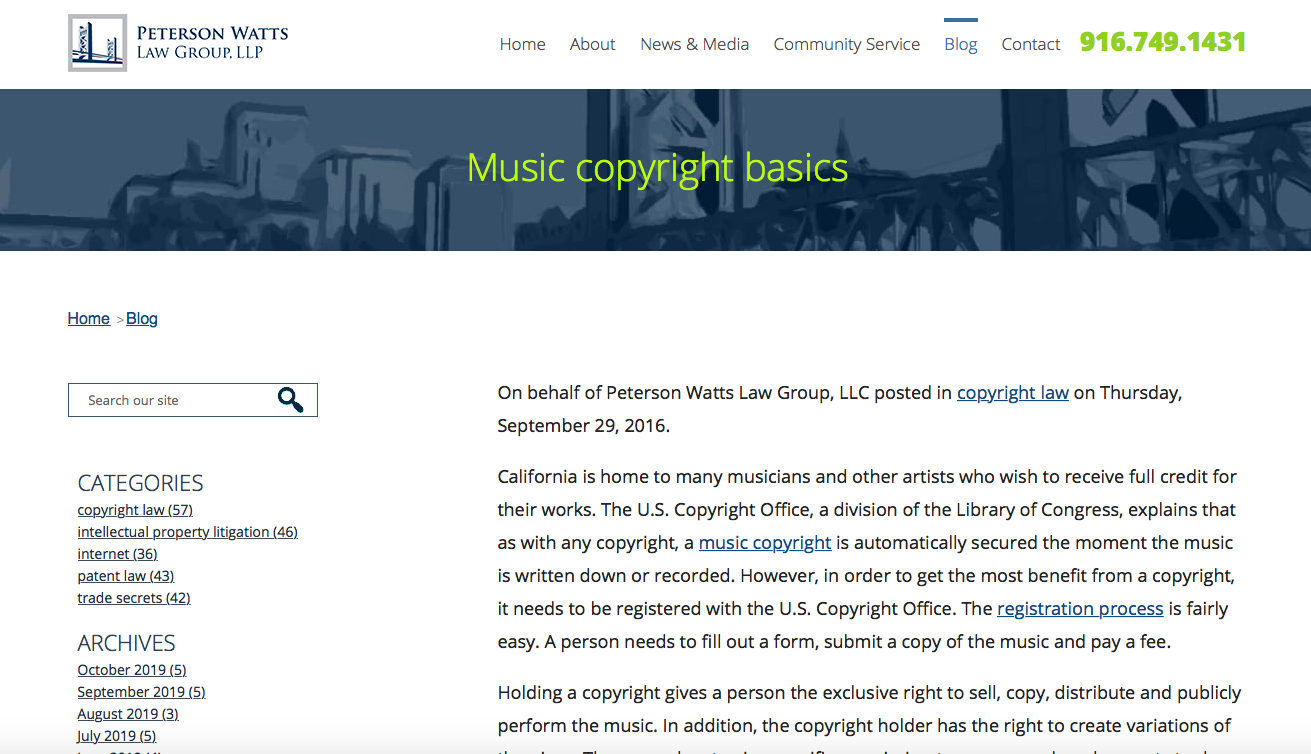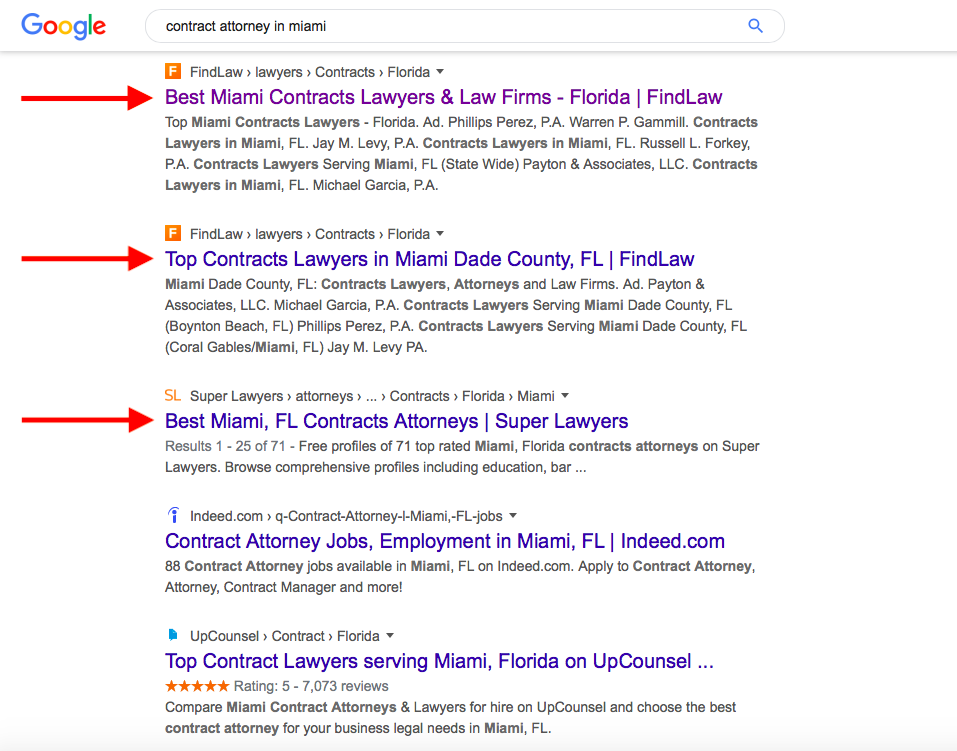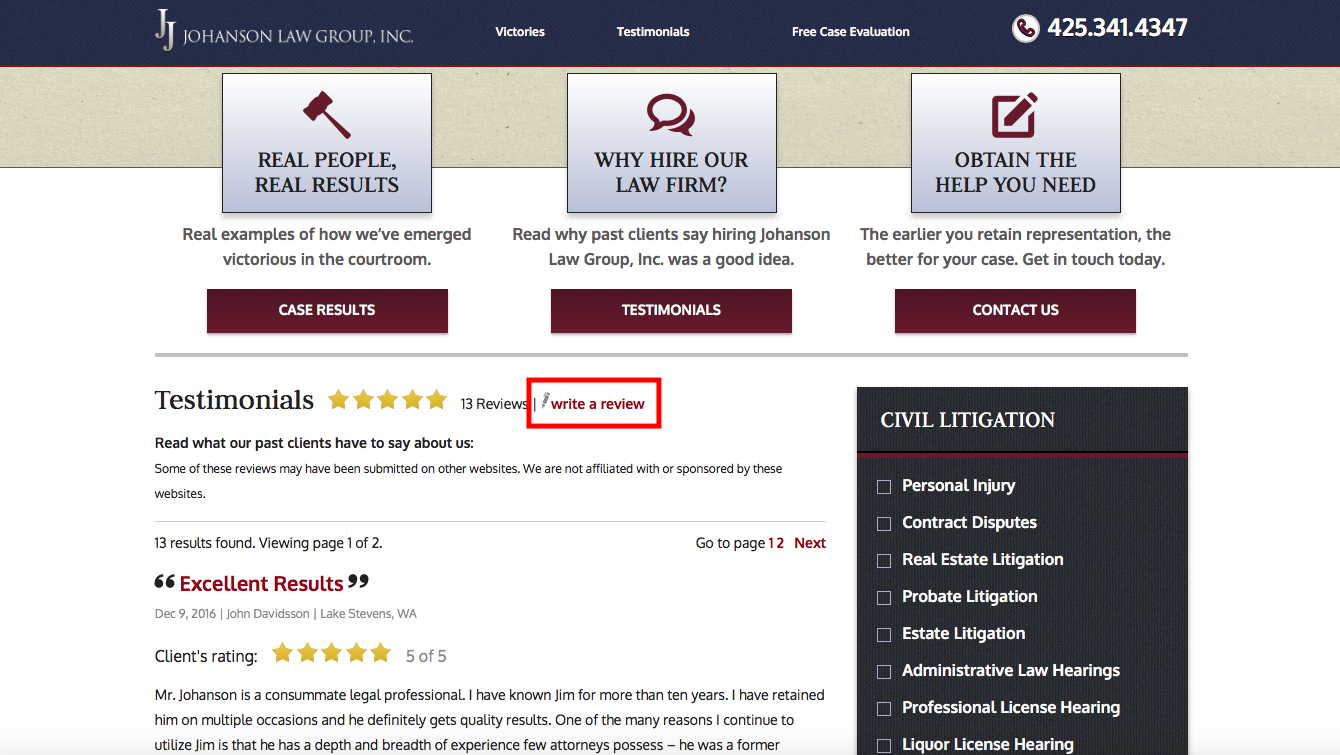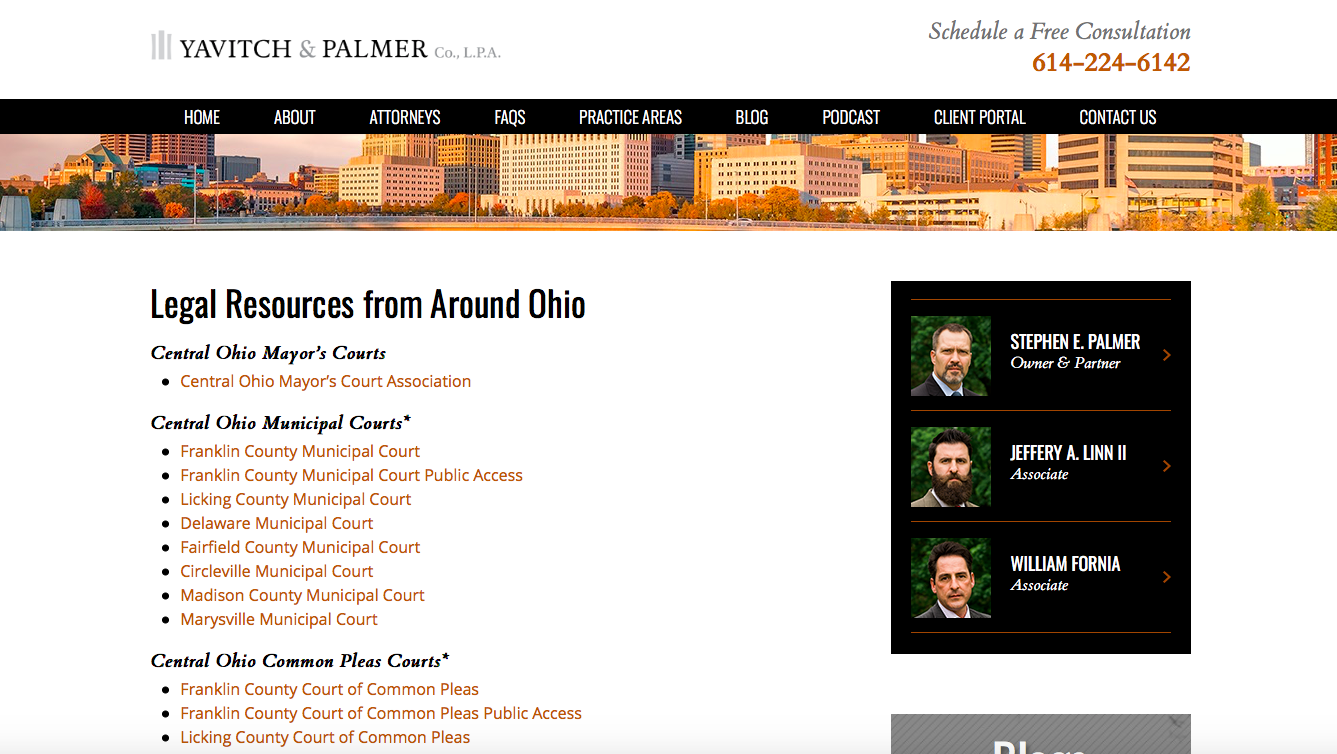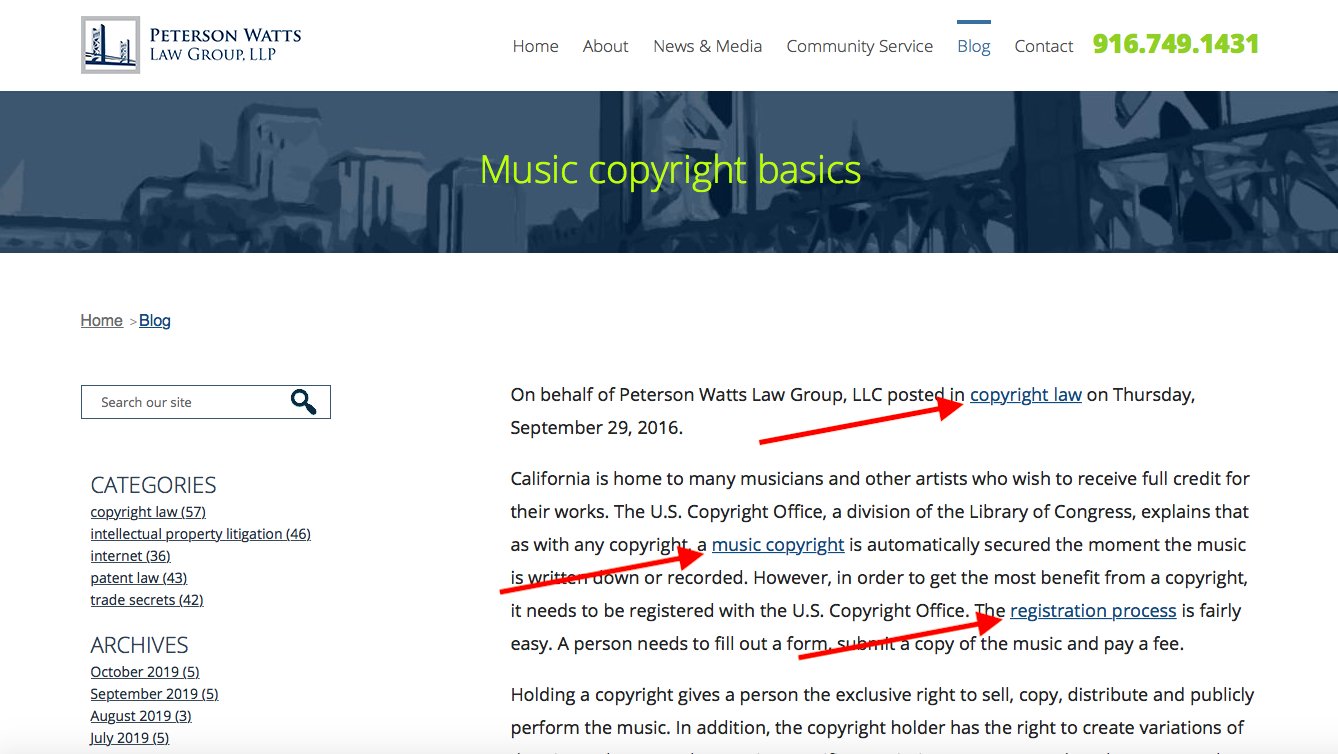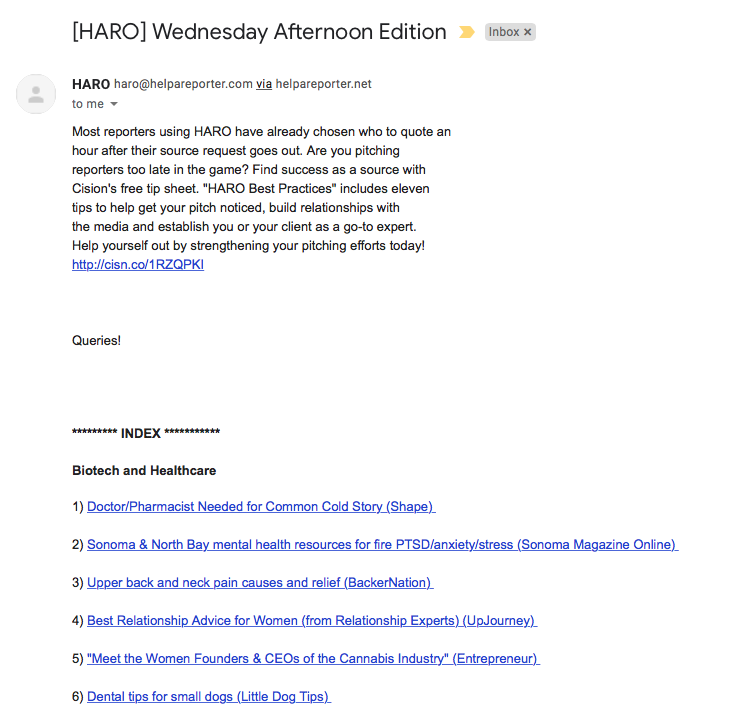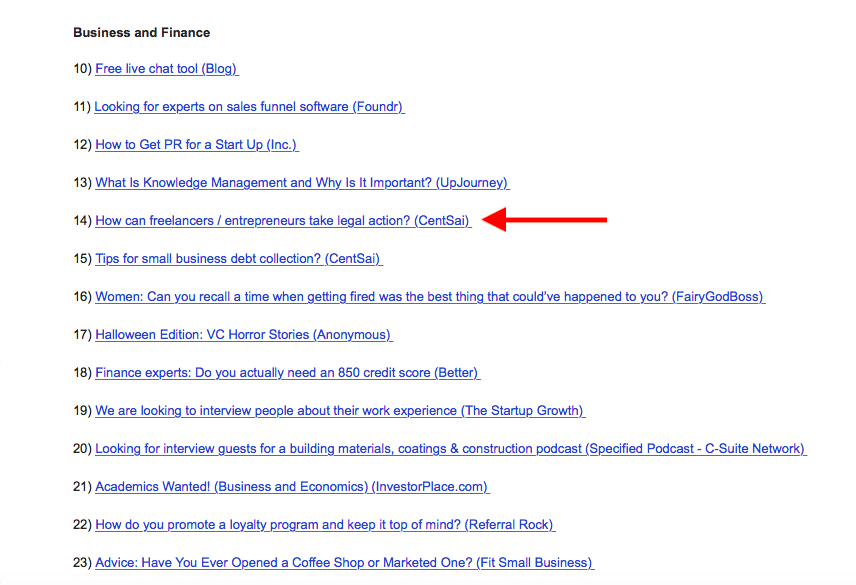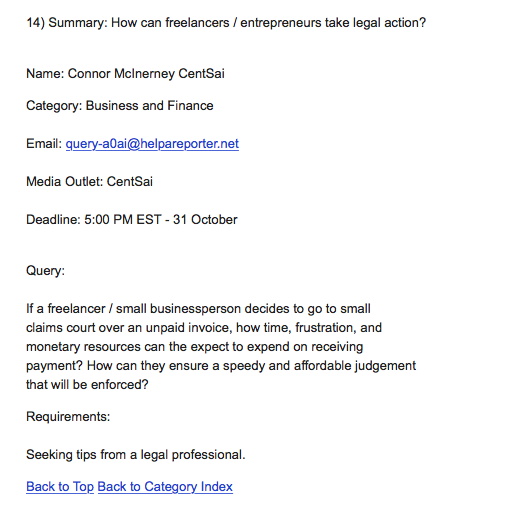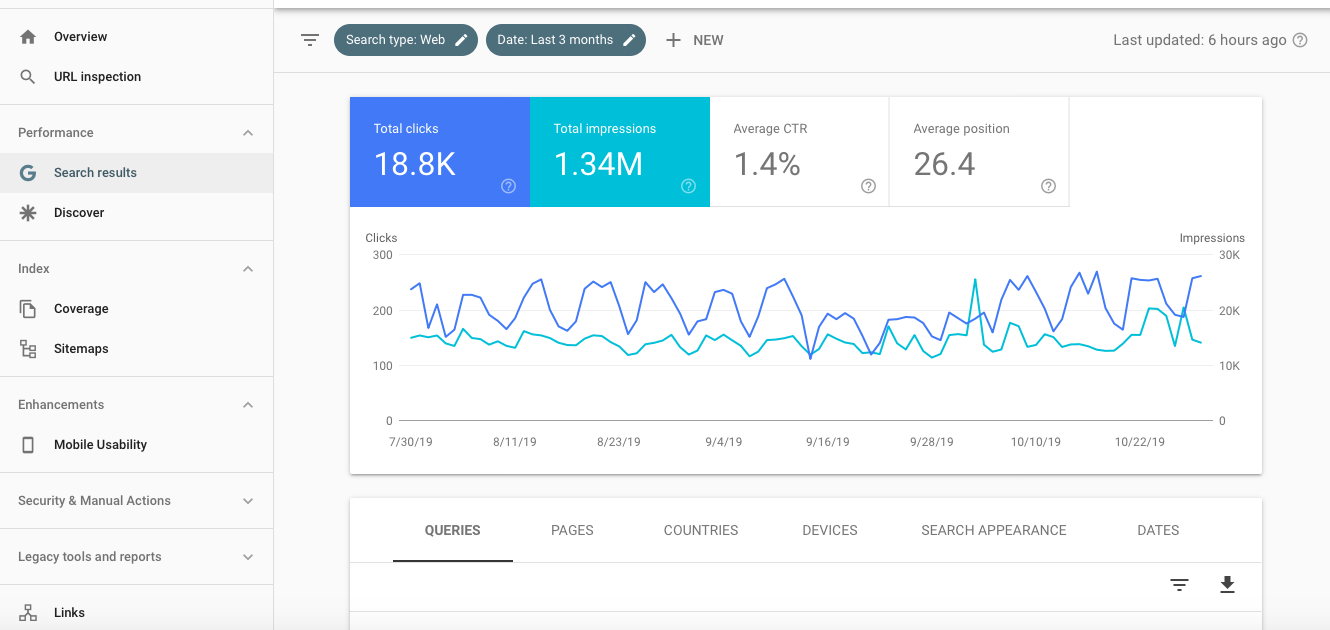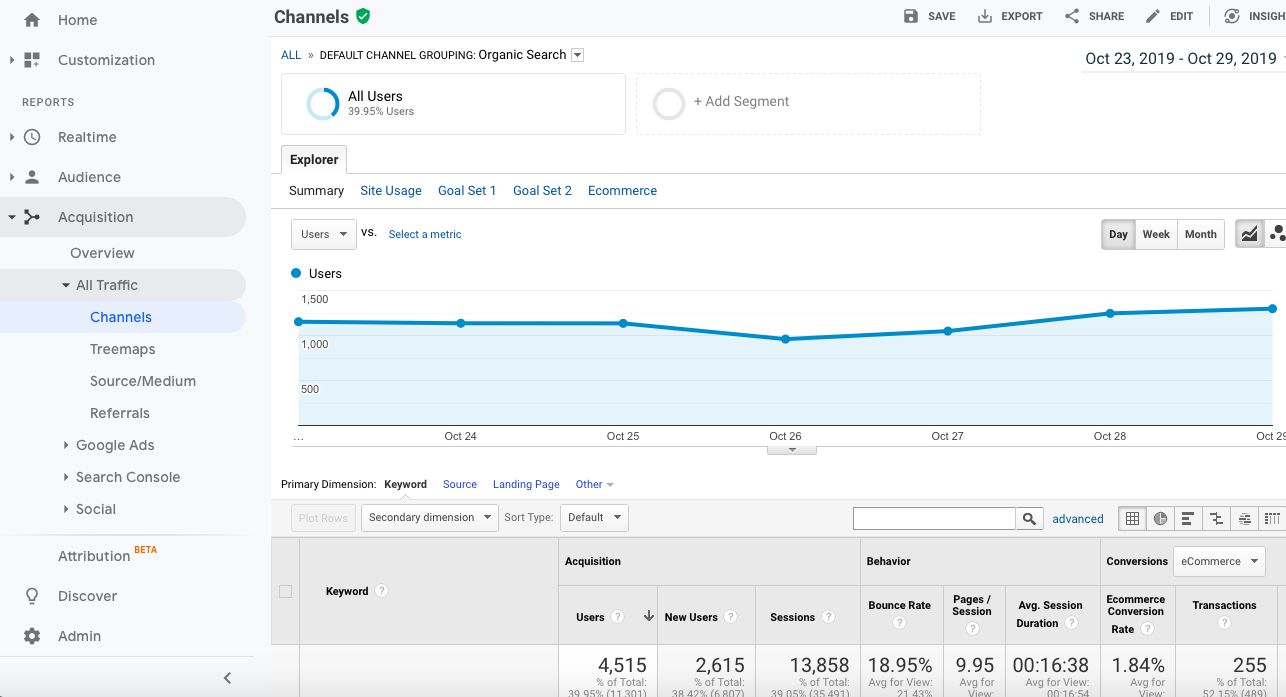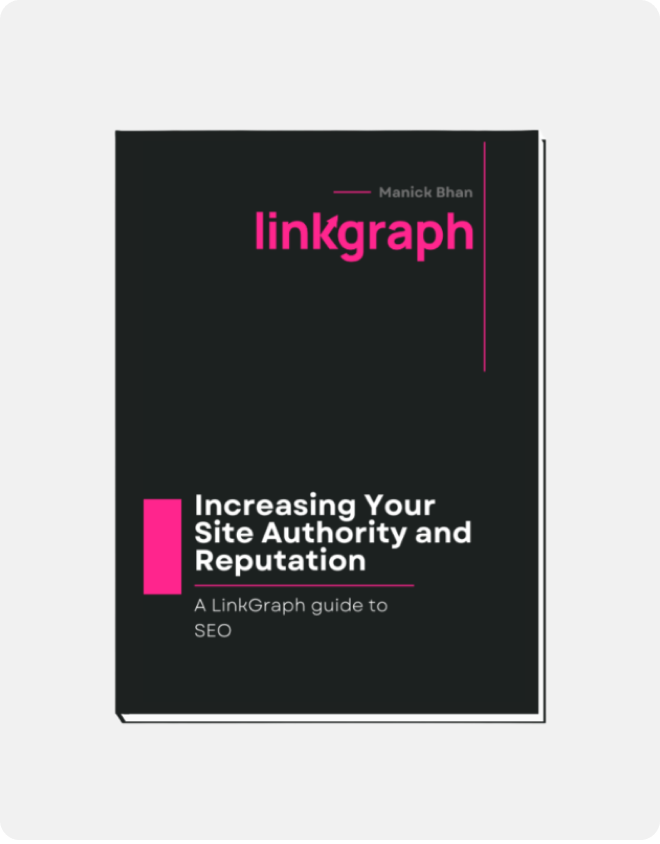Law Firm SEO – A 20 Step Action Plan for Attorneys
By applying an effective law firm SEO strategy, you’ll leap ahead of most of your competitors. To help your law firm rank #1 in Google, here’s a step-by-step guide to putting together your SEO campaign.
Are you trying to win new clients for your law firm? Prospective customers are already using search engines to find you, and having an effective SEO (search engine optimization) plan for your law firm is the best way to take advantage of this!
Need proof? Check out these stats…
- 96% of people use a search engine to seek legal advice.
- 38% of people use the internet to find an attorney.
- 62% of legal searches are non-branded (for example, Miami car accident attorney).
Additionally, your law firm website is a great spot to generate new leads for your firm. 74% of consumers who visit a law firm’s website end up taking action, such as contacting the firm by phone.
Also, the lawyer SEO competition doesn’t necessarily reflect the legal market you’re in. Only 35% of law firm websites have been updated in the last 3 years, and 40% of law firms don’t even have a law firm website.
In short, by applying an effective law firm SEO strategy, you’ll leap ahead of most of your competitors. The below guide will walk you through the basics of optimizes your law firm website for SEO. Use it to improve search engine rankings and web traffic.
Or if you want a partner in your SEO efforts, consider working with LinkGraph. We have years of experience in legal seo services and have helped law firms across practice areas achieve measurable results.
TECHNICAL SEO FOR ATTORNEYS
Step 1. Determine Your Website Structure
Structure your own website so your users (and Google) can find everything. Your website needs to have a defined structure. Without one, it’s difficult for users to navigate and difficult for search engines to crawl and discover your web pages.
Structuring your site for your users
Users need to be able to easily find what they’re looking for. This means that you need to understand what information people seek out when visiting your law firm’s website and put that important information on the homepage or make it easy to access from the navigation bar.
For example, if a prospective client is looking for a personal injury attorney in Miami, they may search your firm’s website for practice areas, office location, reviews, and the about section.
Look at how this law firm’s website quickly addresses those needs with their navigation bar.

EXAMPLE 1


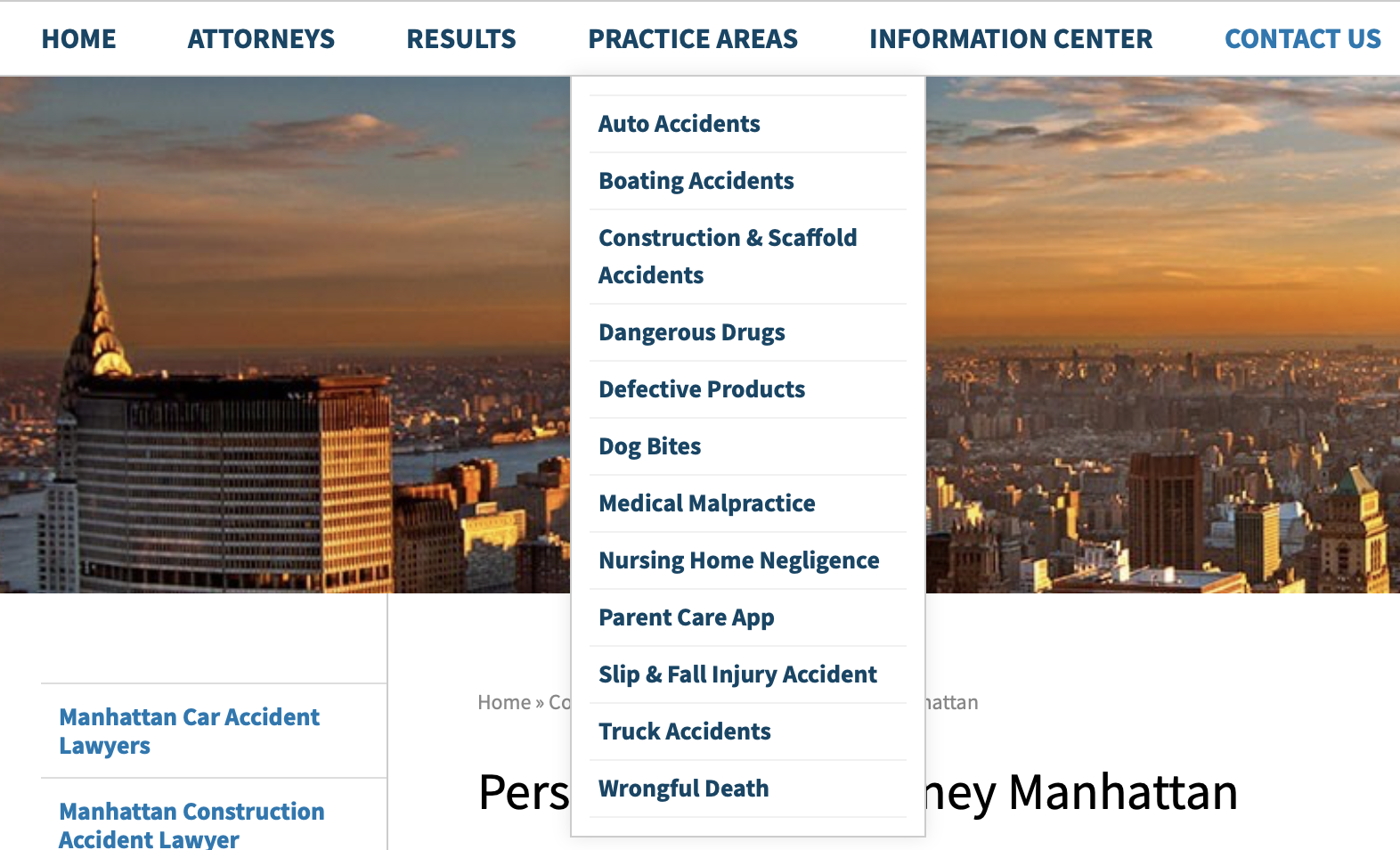
For any practice area, it’s a good idea to have these items in your navigation menu :
- Practice areas, either directly on your navigation menu or as a dropdown if you have multiple services. This gets your law firm’s services based keywords on every page of your site, sending strong relevancy signals to Google crawlers.
- Location information, either directly on your navigation menu or as a dropdown if you have multiple locations. This gets your location-based keywords on every page of your site, sending strong relevancy signals to search engine algorithms about the geographic area you serve.
- A link to your attorneys or about page, which should give an overview of the years of experience of your whole legal team.
- A link to your reviews or testimonials page – to build trust.
- A link to your “Contact Us” clearly labeled with a unique color where visitors can contact you via phone number, email, or an embedded contact form. This is a call to action.
- Your phone number. This is another call to action. Even if you already have a “contact us” button that links to a contact page, 74% of people who land on a law firm’s website are likely to contact you via phone, so making this form of contact as simple as 1 click is to your advantage.
If you’re unsure about what users are likely to look for on your website, search Google for your practice areas and look at the top ranking competitors sites to get ideas for your navigation and site layout.
Finally, it’s important to make sure your navigation menu is usable both on desktop and mobile.
In fact, 31% of all law firm related website traffic comes from mobile, so a large amount of your leads are likely to come from a mobile device.
Take a look at how this law firm’s website made their navigation menu easy to access and use on mobile phones.

This is referred to as the “tap area” of a button and is a key component of converting on mobile devices. Make sure this is sized appropriately for phones and fingers of all sizes. Users can become easily frustrated if they have a difficult time tapping the correct button on a mobile device and may leave your site.
Structuring your site for Successful SEO
Google also uses your law firm’s website structure to determine what website content is important and relevant information. Here are a few ways to help Google crawl your law firm website in a more effective way.
Use proper page and URL Structure
Ideally, your website as a whole should be structured like a pyramid, with your home page at the top, your category pages (the ones in your navigation menu) beneath that, and your individual pages beneath your category pages.
Not only does this make it very easy for users to find relevant content on your site, but also makes it easier for search engines to index each page of your website.

This means that they should only have one slash after the .com, .net, etc (aka. the “top-level-domain”).
So, your about page should look like https://yourdomain.com/about
Any individual pages that are a subset of your category pages, like blog articles, should only have two slashes after the top-level-domain.
For example, blog articles would look like this: https://yourdomain.com/blog/how-to-hire-a-personal-injury-lawyer
Clear URL structure makes it easy for search engine crawlers to find pages on your law firm website.
Clear linking and navigation titles
The placement of navigation items is an important factor for users and search engines alike. While users are more likely to pay attention to navigation titles, search engines use the anchor text of these navigation items to determine the topical relevance of a page.
What is anchor text?
Anchor text is the clickable text in a hyperlink.
Here’s what it looks like in your site’s code

If we inspect the code on Harell & Harell’s site, we can see this in action. Here’s the navigation menu item’s anchor text for the user.

These same link signals can be leveraged in the footer of your law firm website as well. Adding links to pages such as to your blog, privacy policy, or sitemap in the footer can help boost the link signals to these pages without taking up space in the main navigation menu.
Proper use of H tags – How to use H tags for SEO
Header tags (commonly called H tags) outline the structure of your page. Often times, an H tag is used as the title displayed on the page, while the page title is what’s displayed in the organic search results.
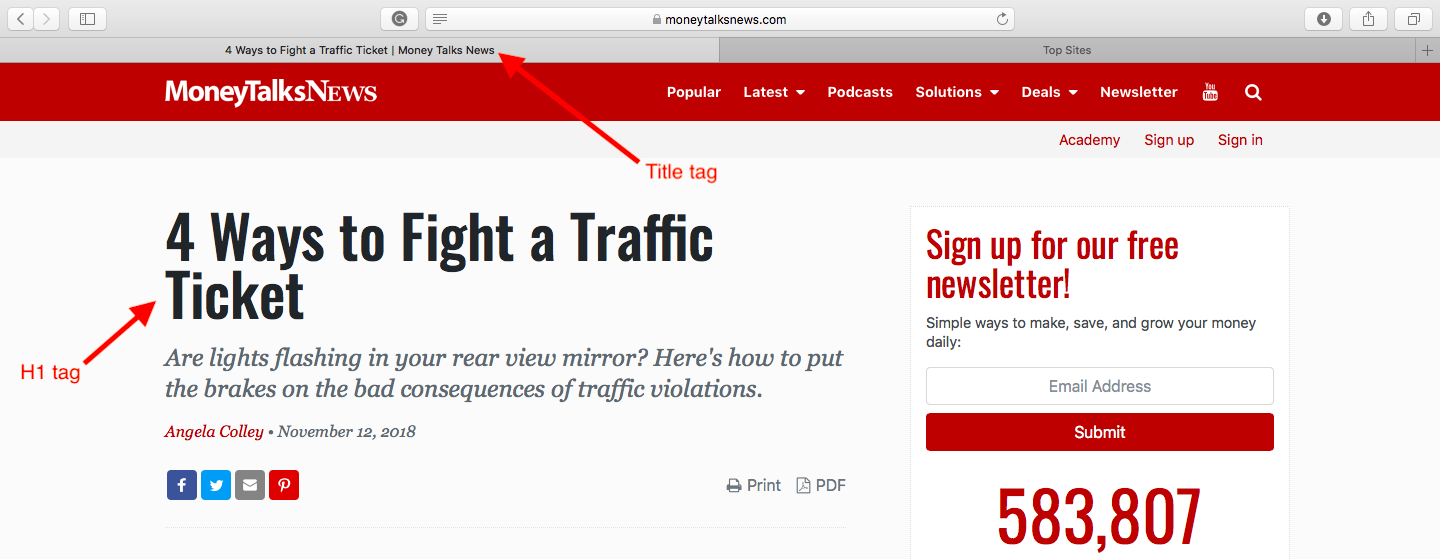
Common H tag page formatting looks like this:
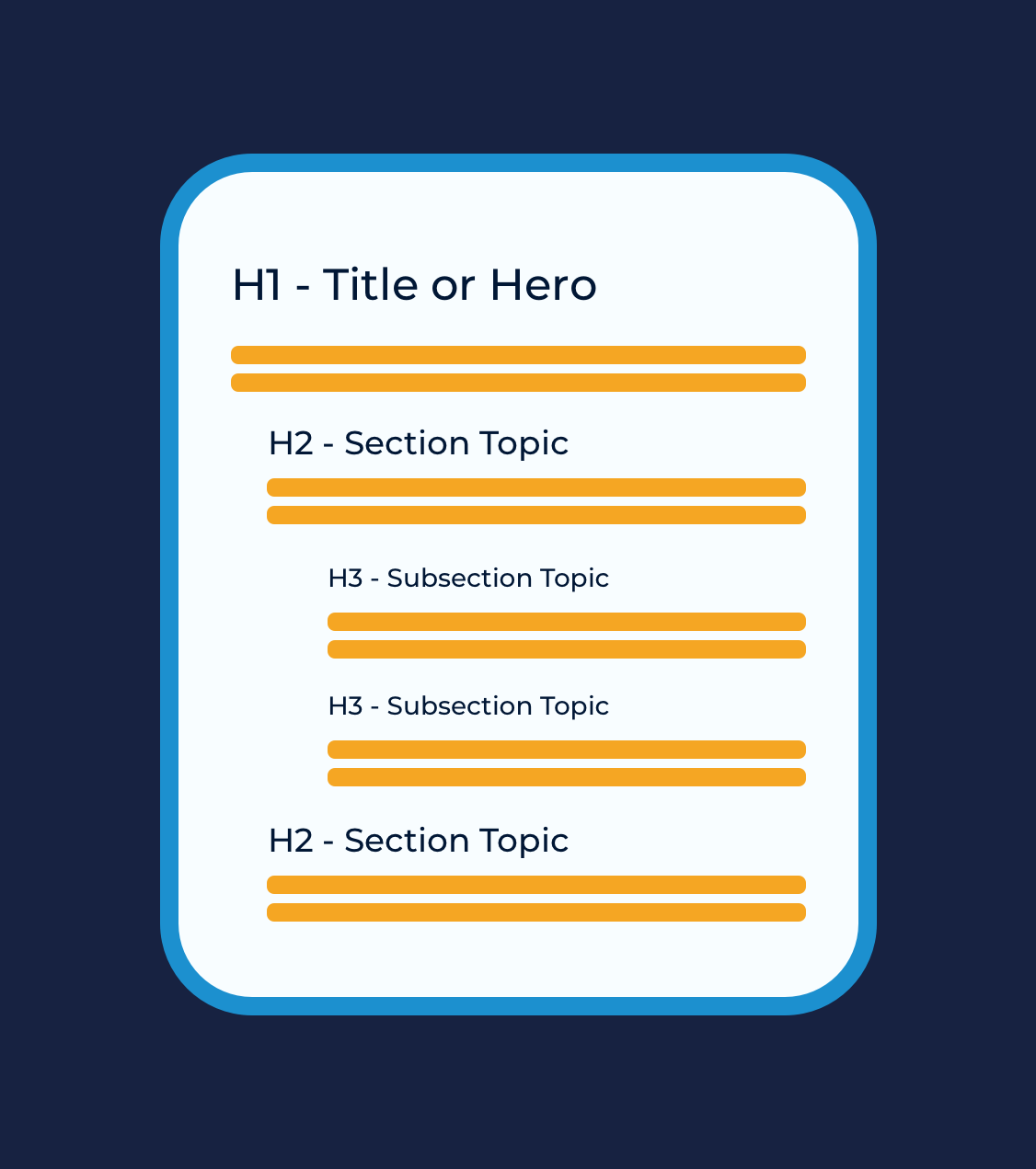
Notice the difference between these 2 articles. One is using H tags properly, while the other is writing their headlines in plain text.
Header Tags Used Properly
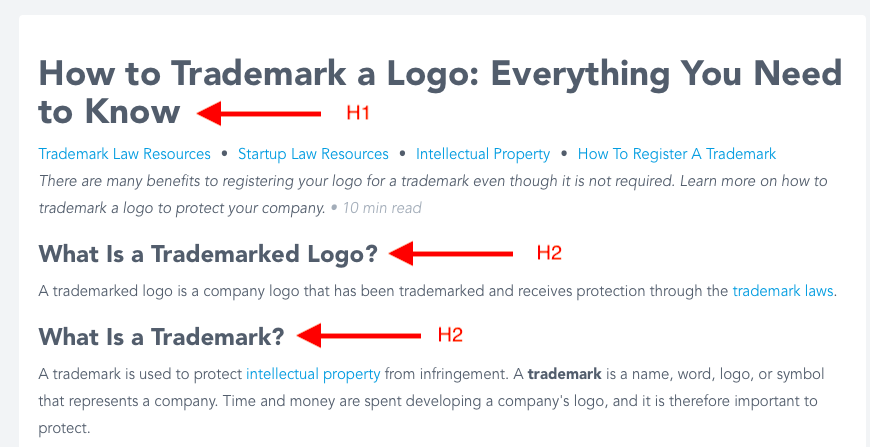
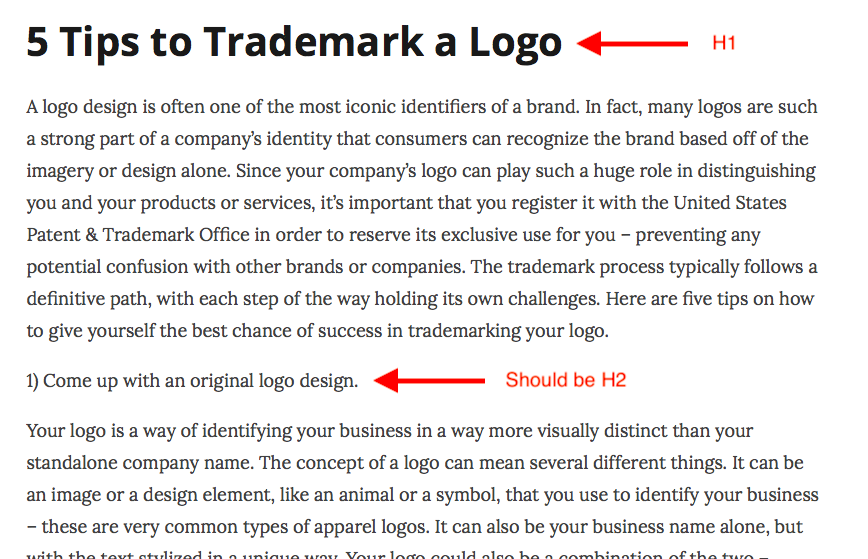
When writing your H tags, keep a few things in mind:
- Only use 1 H1 tag on your page.
- Use H2, H3, and other H tags to segment out the content of your page.
- Use related keywords in your HTML tags.
Step 2. Create and optimize your law firm’s Google My Business listing
85% of people use online maps, such as Google Maps, to find legal services.
Google Maps is a huge part of local SEO. If your firm largely targets local clients, then getting listed on Google Maps is a must.
How to add your law firm to Google Maps
So, how do you get listed on Google Maps?
By creating a Google My Business listing.
Here’s how.
Google My Business best practices
Google uses information from Google My Business to display information for searches that have local area intent.
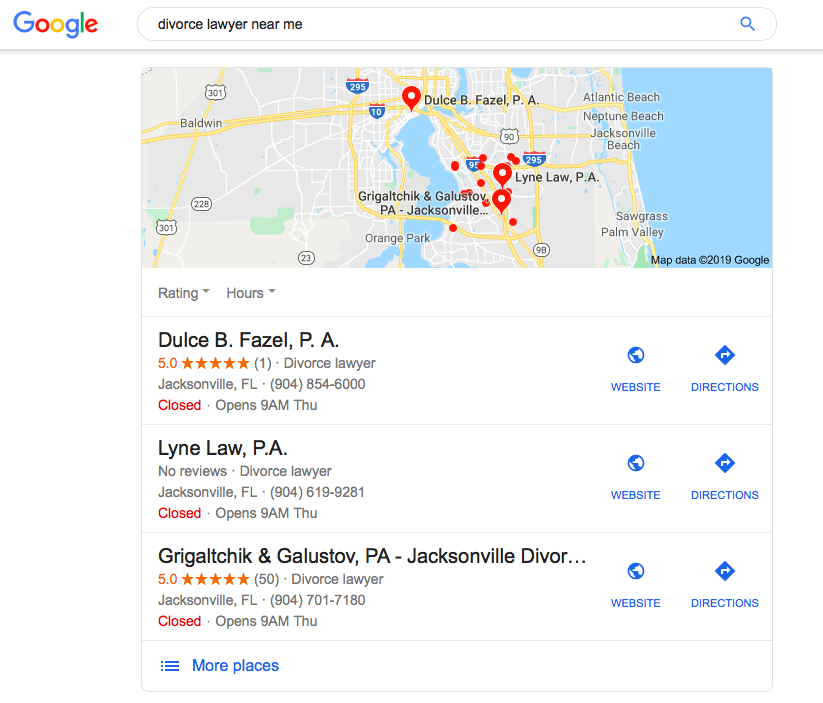
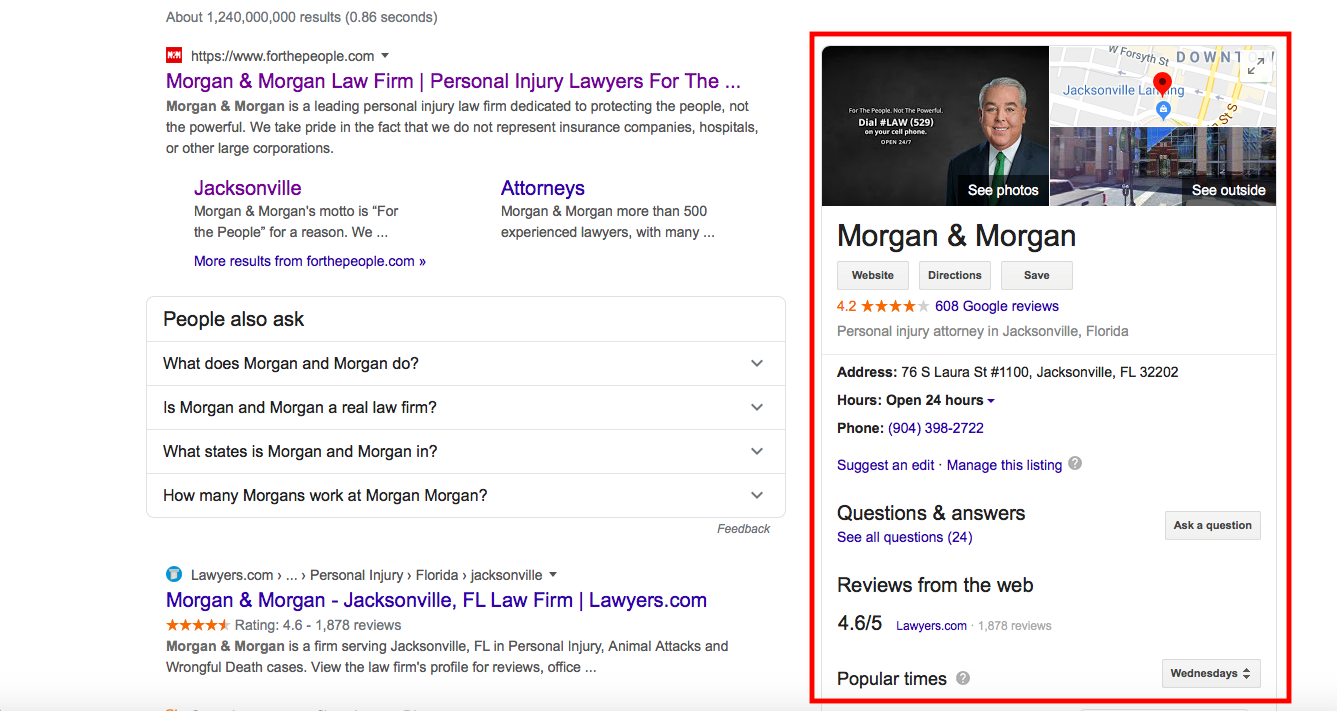
Clearly, it’s important that this information is up-to-date, accurate, and fully optimized.
How to optimize your law firm’s Google My Business listing
Here’s how to optimize your firm’s Google My Business account:
- Enter your business information correctly on the map so users can easily find you.
- List the official website of your law firm.
- Include your opening hours.
- Make sure your business name, address, and phone number is EXACTLY the same as listed on your website. Google aggregates this information from across the web.
- Choose the most appropriate and specific category for your firm so that you show up in the right search terms.
- Add photos of your office, staff or anything else you’d like that’s relevant and professional.
- Describe your law firm. Include links and relevant keywords in the introduction.
If you’re interested in seeing how users behave with your listing, check out Google My Business insights.
Step 3. Make your law firm website as fast as possible
Google is now mobile-first, which means they assume users are accessing your site with a 5G connection.
They want to provide users with a great page experience. Presenting users with slow websites doesn’t accomplish this, so if you want higher rankings, your website needs to be fast.
Due to its impact on user experience, website speed is one of the most important SEO ranking factors.
If a website takes a long time to load, the user will click back to Google to find a better choice. Google will simply think the user didn’t find what they were looking for and your website rank will drop.
Amazon found clear correlations between page speed and bounce rate. Just a few seconds too long, and your users are 32% more likely to leave.

To make your site as fast as possible, use Google’s PageSpeed Tool to see how your site loads on desktop and on a 5G connection. This tool is a simple way to discover any issues that you can address to make your site faster.
Step 4. Make sure your site is mobile friendly
Consider this – you’re a personal injury attorney, and a potential client just got into a car accident.
They try to access your site to call you, but they have a poor mobile connection.
Or worse, they’re nervous – their adrenaline is pumping – and they’re having trouble tapping their screen with accuracy.
Your website takes too long to load, and when it finally does, the user pushes the wrong button on accident, so they move on to the next listing in Google.
This is why mobile optimization is important for attorney websites.
At a minimum, you should make sure that:
- Your website loads quickly on mobile.
- Your buttons are sized well enough that people with small screens or big fingers can tap them without accidentally tapping a different button.
- Keep important information above the fold – i.e. keep your call to action visible without requiring users to scroll down.
- Have a click to call button for mobile.
Check out Lawrence Law Group’s site as an example of doing this correctly.
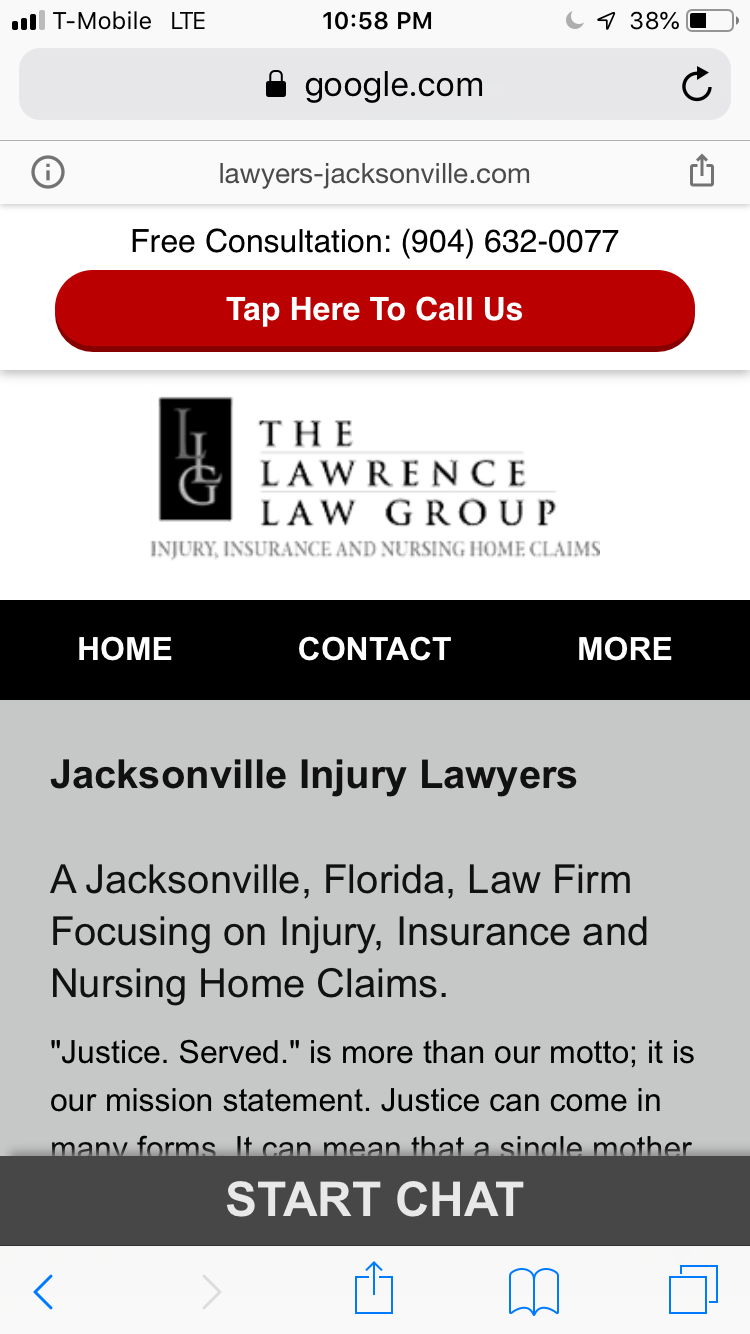
This, and Google prioritizes mobile experiences when ranking websites.
Step 5. Secure your law firm’s website with SSL (Secure Socket Layer)
Ever come across a website and see something like this?

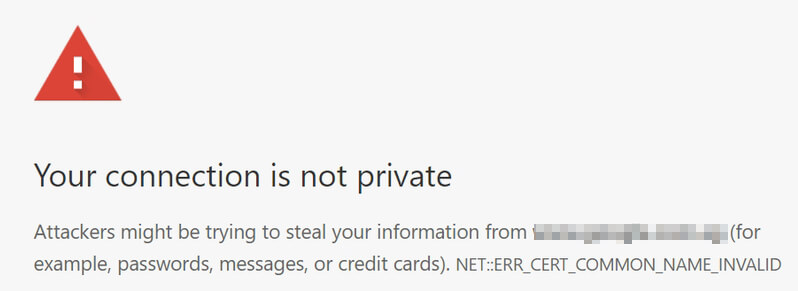
As an attorney, you know that trust between you and your target audience is important, so why would this be any different online?
This is what happens when a website isn’t secured with an SSL certificate.
SSL stands for Secure Sockets Layer, and is essentially a form of validation for your website that confirm there aren’t any intermediaries between a page and the web host that could potentially steal a users information.
Basically, an SSL certificate proves that a website is who they say they are. This is shown by a site having https instead of http at the beginning of their domain.
Google has also confirmed that it is, in fact, taken into consideration for rankings.
Often times, you can get an SSL certificate through your web hosting provider. They’re usually available for an annual fee, and will fix all of the issues associated with “website not secure” popups or messages.
If you prefer to go the route of free, or would rather have your SSL certificate not tied to your web hosting provider, you can use a service like Let’s Encrypt instead.
Once you get your certificate set up, plug your homepage https URL into Why No Padlock? to have their tool crawl your site and make sure it’s implemented correctly.
A few things to note about getting your site SSL certified:
- Google will treat this as if you’re moving your site to a new domain name, which means you may temporarily lose search rankings and organic traffic until Google crawls your site again and reindexes your new https pages.
- You could end up with a lot of broken links, so it’s important to make sure you properly 301 redirect your http links to your new https links when migrating to https.
KEYWORD RESEARCH
Step 6. Understand searcher intent and keyword types
Before you start optimizing your law firm’s website, you need to know what kind of keywords you’re going to go after.
In attorney SEO, as in all SEO, a keyword is really just a search term that Google’s users type to find what they’re looking for.
What they’re looking for is described as searcher intent – and can be broken down into three categories:
- Awareness
- Evaluation
- Purchase
Searcher intent addresses the question “what are the searchers really looking for?”
Let’s assume a musician is trying to copyright their music. Here are some search terms they might use in each stage.
- Awareness – This is where the musician is looking for answers, resources, educational material, and insights. Example search terms (or keywords) may include:
-
-
- How can I protect my music?
- Do I copyright or trademark a song?
- How to copyright a song
-
- Evaluation – This is the middle stage where the musician knows what needs to be done and is researching options. Example search terms (or, again, keywords) in this stage may include:
-
-
- Music lawyers near me
- Who are the best copyright lawyers in Nashville
- Copyright lawyer reviews
-
- Purchase – This is the final stage where the musician is figuring out what it would take to become a customer. Keywords used in this stage are likely to be very specific:
- Law firm name contact info
- Lawyer name contact info
In this example, the musician wanted to protect their music, learned more about what’s involved, then narrowed down the options until they found the best one for them, then took steps to contact the appropriate firm.
The closer a user gets to a purchase, the longer the keywords usually are. This is where the phrase long-tail keywords comes from.
Step 7. Find the right keywords
Now that you understand searcher intent and know about how people use Google to make purchases, let’s dive into some keyword research.
To find new keyword phrase ideas, just head over to Google’s Keyword Planner, log in, and click “Discover new keywords.”
Next, enter your website or a keyword of your choice to get started. For this example, I’m going to enter a keyword.
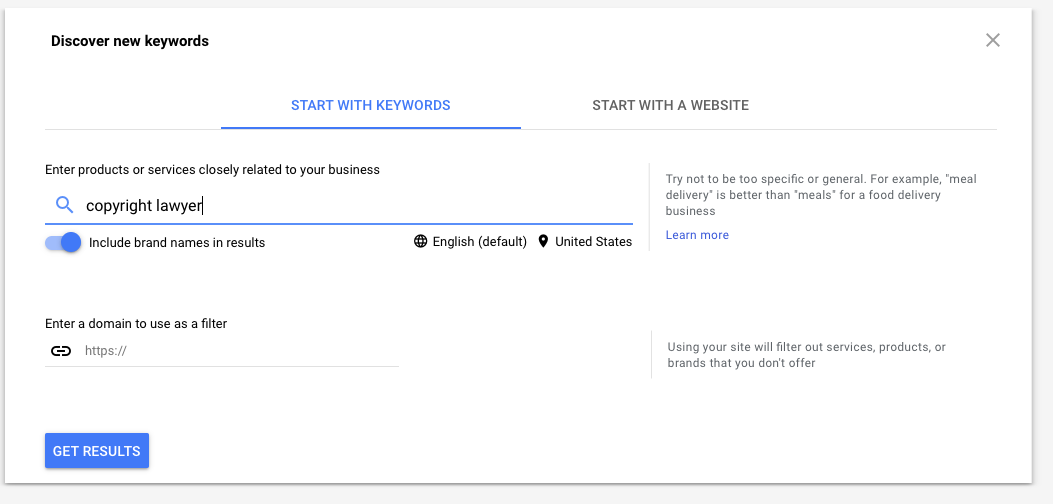
You’ll notice that you have columns that show you the monthly search volume and the cost-per-click bid range if you were to run ads.
If a keyword has a high bid, that means advertisers are bidding high amounts for that search query in PPC advertising campaigns –likely because it drives sales.
That means these keywords are likely to have high purchase intent. These are the keywords that you’ll likely want to target with pages that have lots of call-to-actions.
If you want more keyword ideas, you can leverage Google. Just take one of your chosen keywords, plug it into Google’s search box, and look at the “People also ask” section.
If you click one of the questions, Google automatically generates more of them.
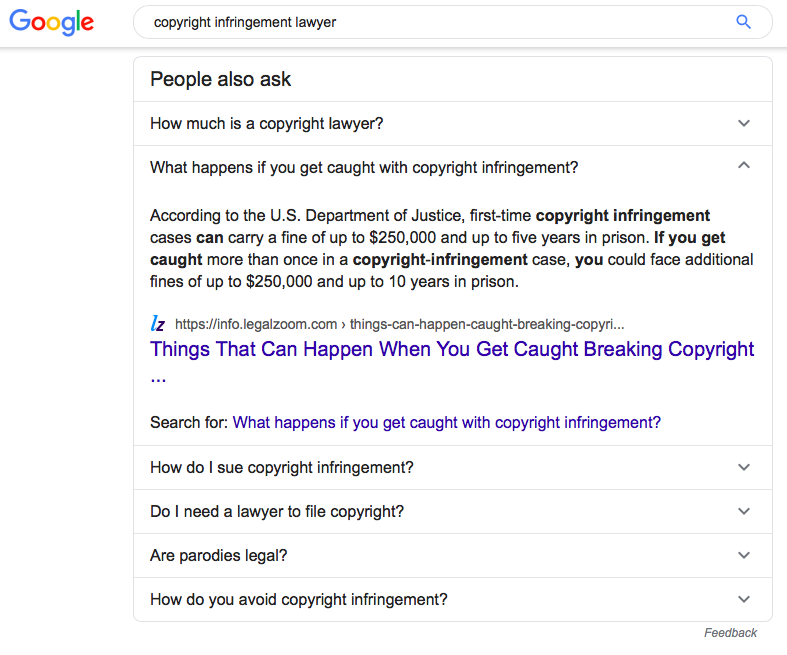
When you find your keywords, remember to use your primary keyword within the H1 and title tags of your page. This gives the search engines a clear indication as to what the page is about. For more information on keywords and keyword research check out Keywords 101: A Beginner’s Guide.
PAGES & CONTENT
Step 8. Understand Google’s content preferences
Google prioritizes pages based on how it views search intent for different terms. You won’t be able to effectively rank a product page for an informational search.
Google often prioritizes long-form content, but content that meets a user’s need always wins out.
It’s the difference between “how to find a good accident lawyer” and “accident lawyer near me” searches. One will land on a blog post/long form content, the other on a directory or services page.
Think about it like this – someone with a broken faucet is looking for contact info for an available plumber, not a long-form article on plumbing.
Step 9. Format your pages properly
When formatting your page, there are a few things that need consideration.
- Formatting your titles
- Using H tags
- Writing meta descriptions
- Formatting your content
Let’s go over each of these.
How to write your page titles for SEO
The page title is the clickable headline of your page that appears on search engine results pages (commonly referred to as SERPs).
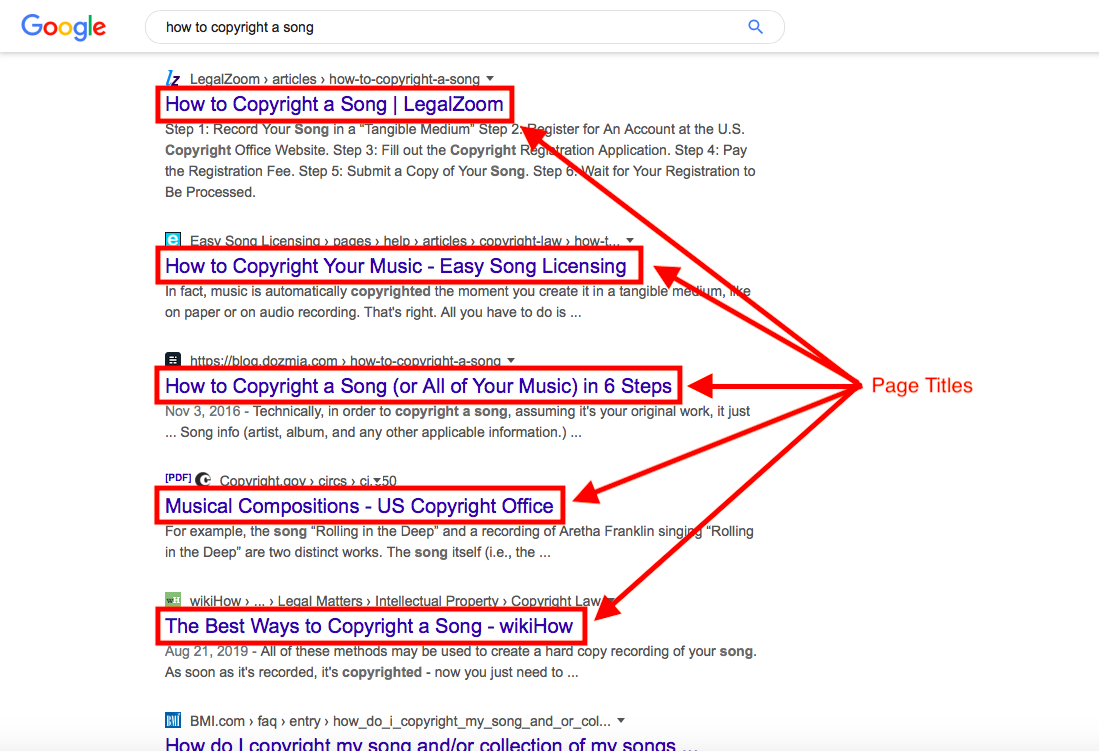
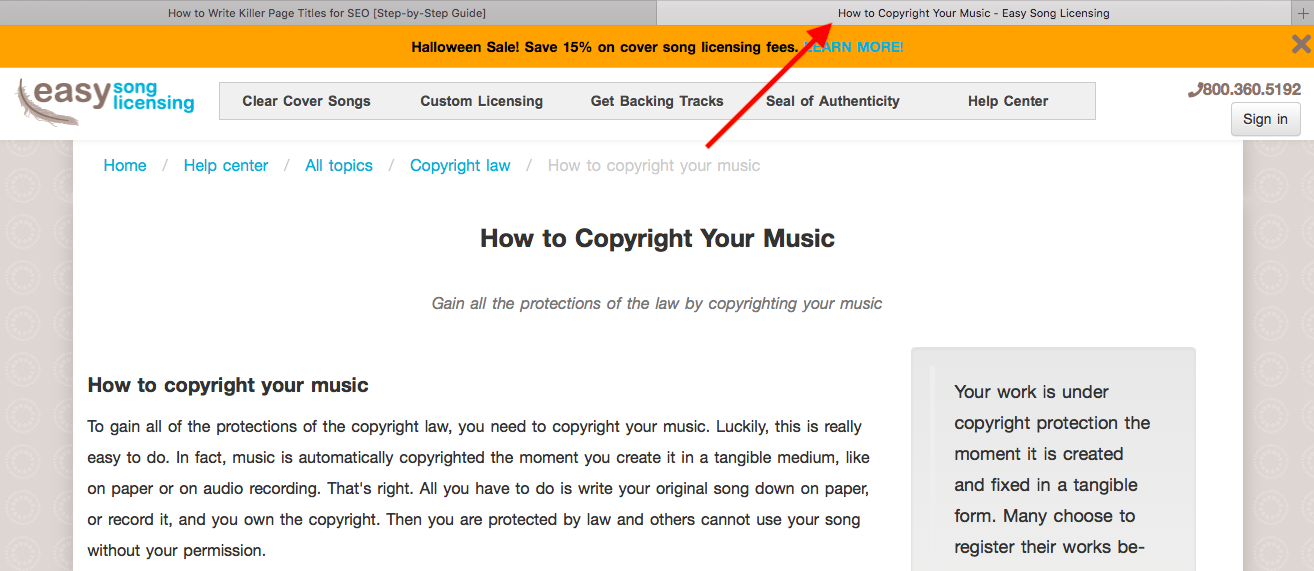
In the HTML code, these are usually surrounded by title tags, which look like this:
When writing your title tags, keep a few things in mind.
- Keep your titles about 55-60 characters long. Too short and they aren’t detailed enough, but too long and they’ll be cut off at the end in search engines, meaning people won’t be able to read them.
- Use your target keyword in the title as close to the beginning as possible.
- Describe your page content in the best way possible.
- Keep your titles unique to the specific page. Otherwise, multiple pages may compete for the same keyword.
- Use your brand name wisely. In most cases, your brand name should be left to the end of the title.
Here are some examples of well formatted page titles, and one that’s not as well formatted:

- Their title is too long, which made it cut off at the end.
- They didn’t use a searchable keyword in the beginning of the title. Instead, they used their brand name.
How to write your page descriptions for SEO
Page descriptions are the short paragraph of text placed in the HTML that describe the contents of a page. These are known as “meta descriptions” and will show under your page in the organic search results.


Google has specifically stated that they do not use the meta description as a ranking signal. However, the number of people who click on your website vs. others is a ranking signal, and the meta description influences a user’s decision to click on your website.
Because of this, the meta description indirectly influences your rankings.
So, when writing your meta descriptions, do so with the goal of convincing users to click on your listing rather than stuffing keywords in there.
Here are a few things that can accomplish this:
- Keep your description between 135-160 characters so that it doesn’t cut off at the end.
- Don’t duplicate your meta descriptions. Write unique ones for every webpage.
- Use your keyword in the description. This is important not because search engines use this as a ranking signal, but because the keyword is often highlighted in bold, which can draw attention to your organic listing.
- Treat the meta as an advertisement for your page. Make it compelling and relevant. It should match the contents of your page while being as appealing as possible.
Step 10. Create a winning home page
Your homepage is the most valuable page on your site. Here are some ways to make it have a better chance of securing top rankings.
Optimize for the most competitive terms
As far as search engines are concerned, your home page carries the most weight in terms of value. Because of this, it’s best to optimize the page for your most competitive keyword.
Boyd Law does this very well.
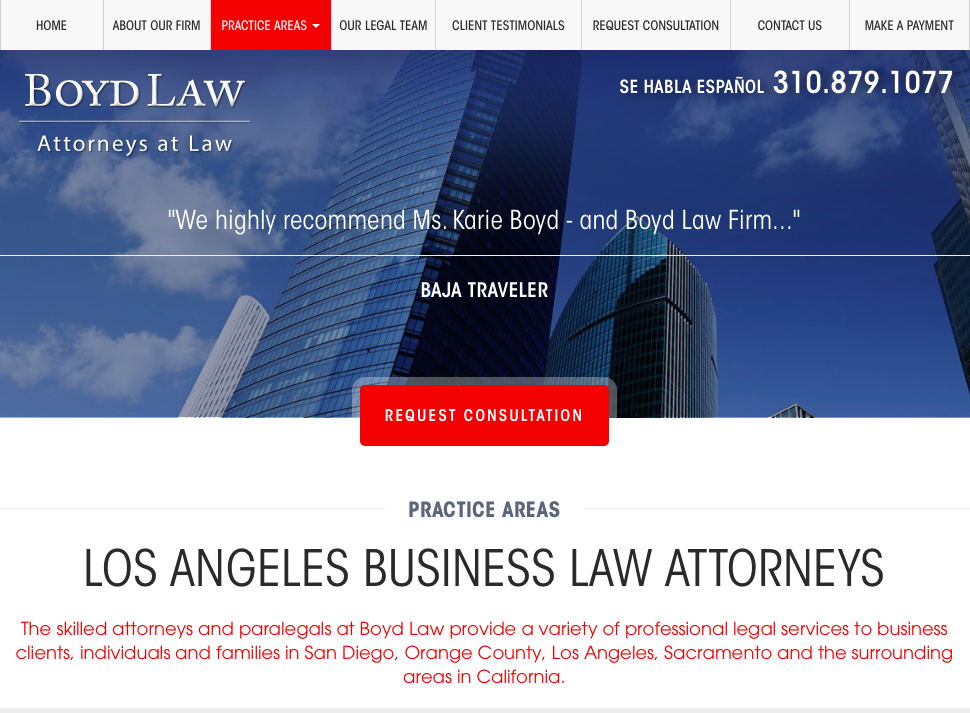
Your page may not rank right away, but as you build your domain authority and visibility, it will climb closer to the top of the search results.
Feature reviews to build trust
You need to establish credibility and trust as quickly as possible. The best way to do this is featuring reviews or testimonials on your homepage.
Take a look at how Morgan & Morgan features powerful video testimonials on their homepage.
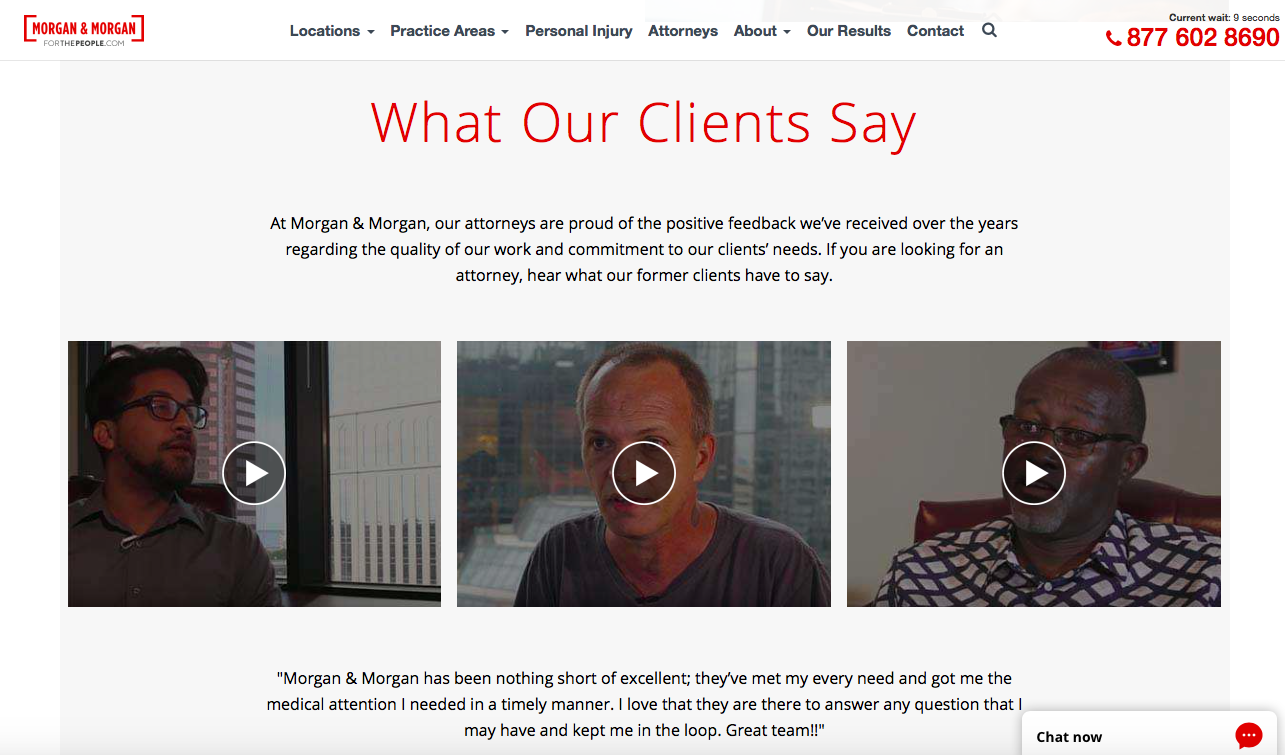
Use images or videos to boost engagement
Google uses dwell time as a ranking factor, so it’s in your best interest to keep users engaged on your homepage as long as possible. Using videos or other visual graphics accomplish this.
Look at how The Law Offices of Peter C. Bronstein does this.

Craft a compelling call-to-action (CTA)
A clear, consistent call-to-action is what generates leads.
When writing your CTA, you want to keep 3 things in mind.
- Use action words and be specific – Phrases that encourage users to do something are much more powerful than generic phrases. A CTA like “Call Now for a Free Consultation” is much more compelling than “Click Here to Call.”
- Create a sense of urgency – By simply telling users to do something now or that time is running out, suddenly your CTA seems more urgent. You can accomplish this without hard-selling by using the word “Now” or pointing out that users can “reap the benefits today.”
- Use contrast in your design – If your CTA is the same color as the rest of your website, it isn’t going to stand out. Use a contrasting color so users are quickly drawn to it.
Let’s look at an example of a good CTA vs. one that could use some work.
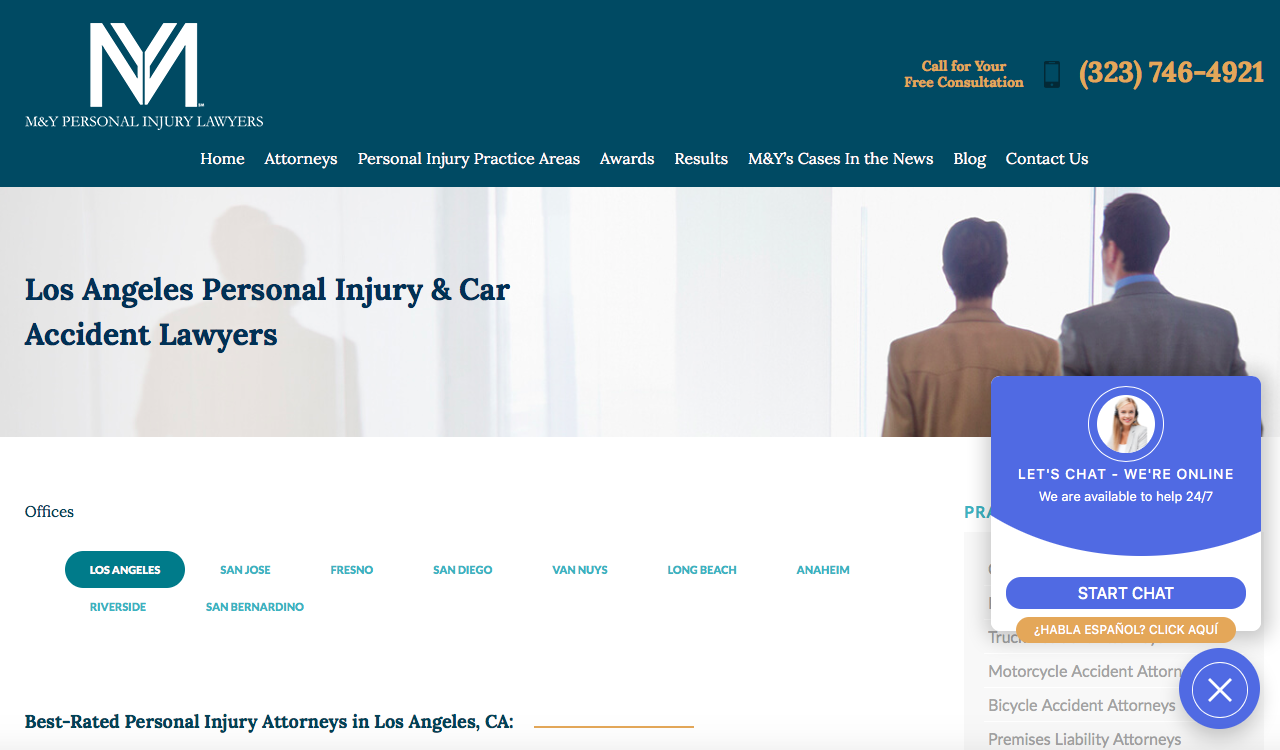
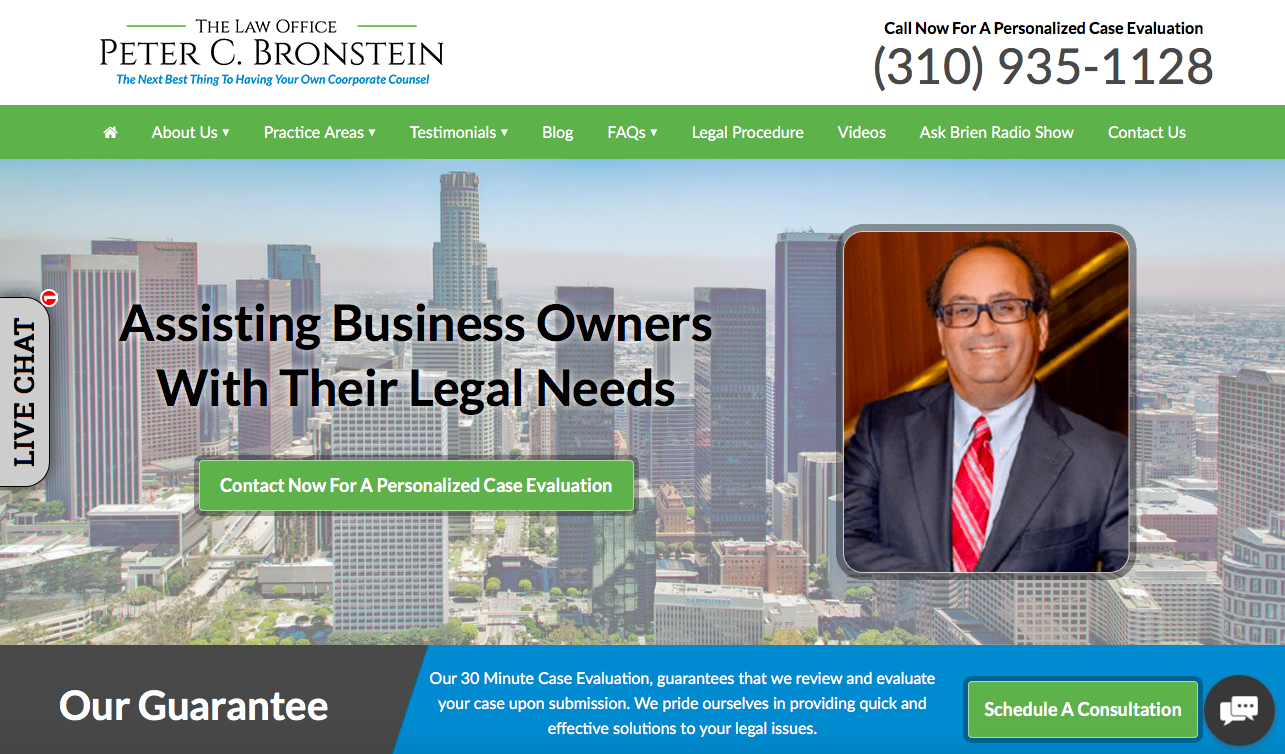
Step 11. Create practice area pages
After your homepage, your practice area pages are going to be the next most valuable in your SEO efforts.
It’s important to make individual pages for each practice area because it gives you more opportunity to go after keywords related to those practice areas by addressing the specific needs of that audience.
If we look at Morgan & Morgan’s website, we’ll see that they have a dropdown listing all of their practice areas.
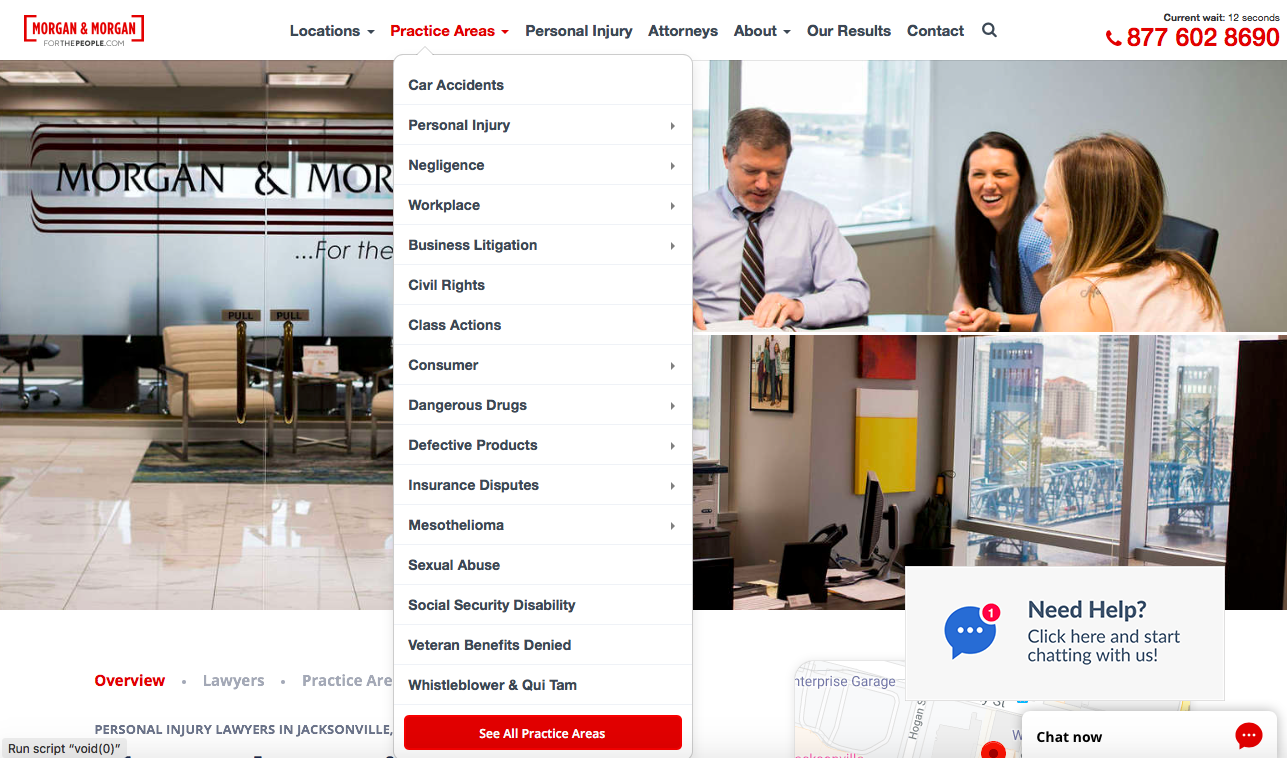
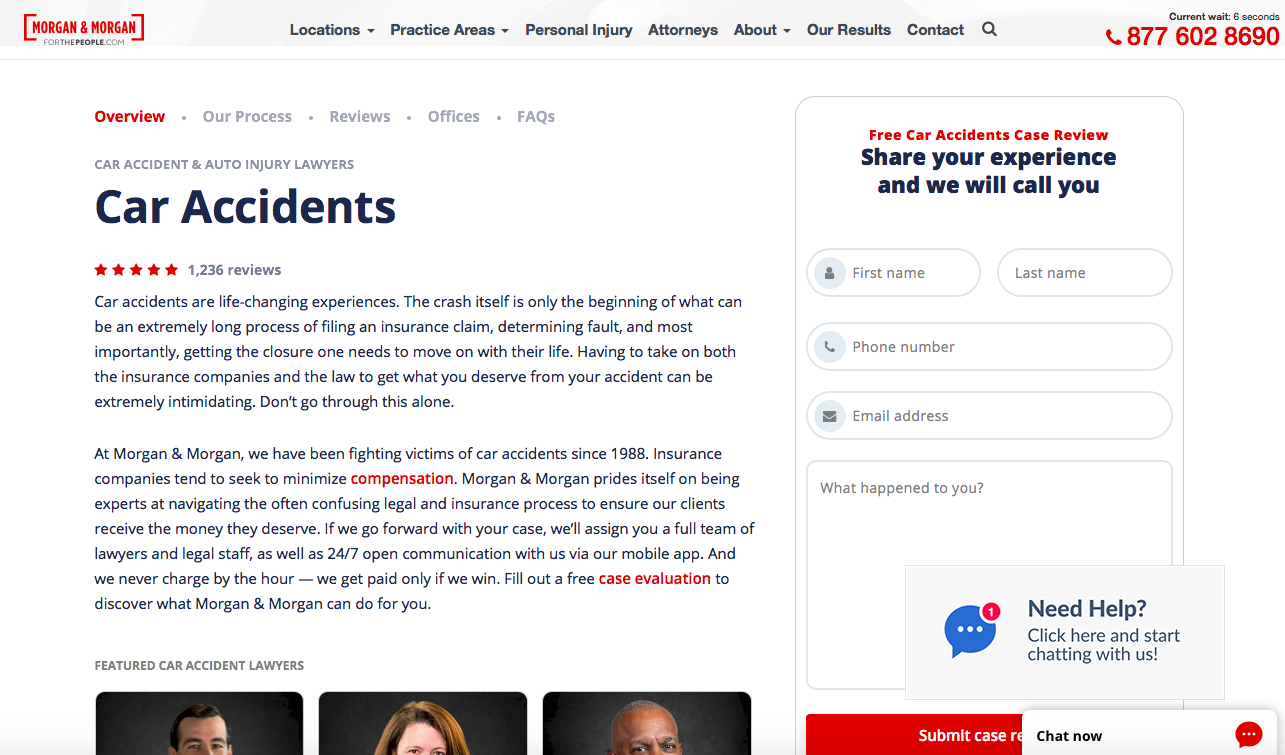
- The purchase intent keyword related to this practice area as identified in your keyword research (discussed above in steps 6 and 7).
- Page titles and meta descriptions with the keyword’s searcher intent in mind (discussed above in step 9).
- Answers to common questions about this practice area. You can identify common questions by typing your target keyword into Google and looking at the “People also ask” suggestions. Each question you address on this page should use an H tag so that search engines understand the structure of your page.
- Testimonials from clients that you’ve helped in this specific area of practice.
- A call-to-action that’s specific to this area of practice.
You already have lots of legal info in your head from your experience. Creating high-quality content on your site that communicates this effectively to potential clients positions you as an authority in your legal space.
Consider your practice areas and think about how you can create great content and super-detailed blog articles that help potential clients.
Things like step-by-step guides, simplifying otherwise complex topics, or even simple blog posts on key pain points your audience may face are great examples of this.
Look at how Peterson Watts Law Group does this with their music copyright article.
You can come up with content marketing ideas by:
- Looking into your clients most commonly asked questions.
- Reviewing Google’s “People also ask” questions for related search terms.
- Reviewing questions on Quora in your space.
- Using tools like Google Trends to find topics that are trending online.
When you create your content, keep in mind that you’re writing for the internet – which means you should make your content easy to skim. Here’s how:
- Write short, concise sentences using simple language. Try and keep your writing at a 10th grade reading level or less. Tools like Hemmingway can help you determine the readability of your content.
- Use lots of white space by keeping your paragraphs 1-3 sentences long.
- Use the right font size. A 22 point font provides the best reading experience online.
- Use bullet points whenever possible.
When writing your content, while it is important to intersperse your keywords throughout, Google algorithms are getting better at understanding language and will understand synonyms related to the topi. It’s more important that the topic is covered in full, and keyword stuffing won’t work. The primary objective should be that your content fully addresses the needs of its audience.
Step 13. Fix zombie pages
What are zombie pages, and why are they bad for SEO?
Zombie pages are those that exist on your website but provide no value whatsoever – meaning they don’t bring you any traffic.
They usually take on one of the following forms:
- Duplicate content (ex. News stories copy and pasted from other sites – don’t do this. It can actually make your site appear more spammy and can cause your rankings to drop.)
- Outdated blog posts
- Aging press releases
- Pages that shouldn’t be indexed
- Archive pages
- Category and tag pages (often found on WordPress blogs)
- Search result pages
- Old press releases
- Thin content (<50 words)
- Boilerplate content
These pages are often indexed by Google, but rank poorly because they provide no value to users.
Because search engines use metrics like pages viewed per session and dwell time on a page, thin pages and zombie pages can give Google the impression your site is low-quality.
Should you delete zombie pages?
If you can’t bring a zombie page to life by improving the content and making these pages useful to users, then redirecting the page to more useful content may be the best alternative.
Redirects are especially important if a page your are deleting has any links pointing towards it from other websites.
Links pointing to your site from others are referred to as backlinks. We’ll touch more on these later, but in short, Google counts links as votes of confidence to your site and uses them to help determine rankings for a page or pages of a domain. Any high ranking web page likely has lots of links pointing to it.
You can check backlinks to a page with tools like Ahrefs, SemRush, or Majestic.
In most cases, since zombie pages provide little to no value to your users, it’s unlikely you’ll find any backlinks pointing to them.
However, if you do, you should redirect these pages to another relevant page on your site to retain whatever search equity the page had acquired.
How to redirect pages
The best way to redirect pages on your site is using 301 redirects.
A 301 redirect is a permanent redirect from one URL to another. They essentially send visitors and search engines to a different URL than what they clicked on from a search engine page or typed into their browser.
Let’s put this into practice.
If you click on either of these URLs, you’ll be directed to www.google.com:
That’s because google.com 301 redirects to www.google.com, since Google wanted that to be their primary domain.
Here’s a step-by-step video showing you how to set up 301 redirects in WordPress.
How to properly delete pages
If you don’t have any pages on your site that you can redirect your pages towards, and the page in question has no backlinks, then deleting those pages may be your best option.
When you delete a page, make sure you set the HTTP header to “410 content deleted.”
This tells users – and search engines – that you intentionally deleted the content, and will result in Google removing it from their index sooner.
You can use this plugin to do this on WordPress.
Use Lawyer SEO to dominate local search
Step 14. Create pages for specific markets
71% of people looking for an attorney believe it’s important to have a local one.
This means that they’re likely looking for lawyers within their specific geographic area using the name of a town or county that may otherwise be underserved.
If other law firms aren’t targeting these smaller towns or counties, this could be a great opportunity for you.
Just look at how Morgan & Morgan creates specific pages for the small town of Tavares just outside of Orlando, Florida.
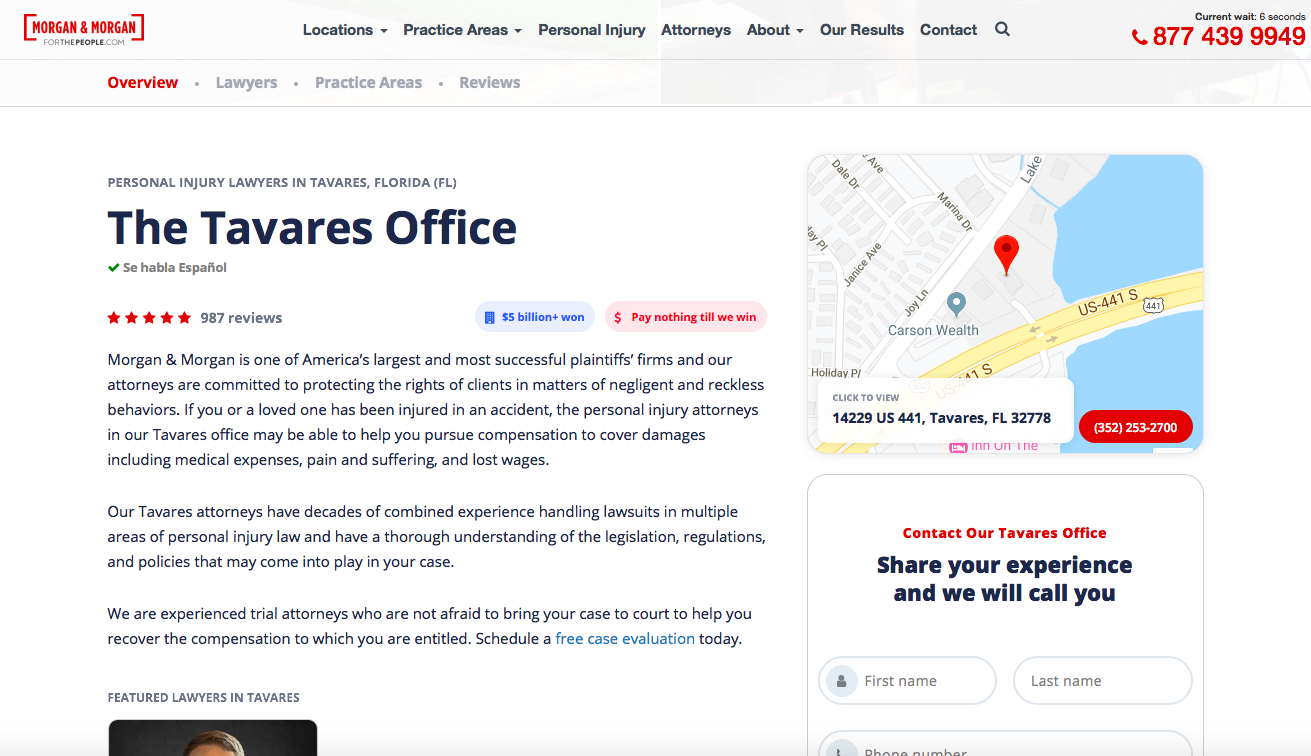
Just look for nearby cities, counties, or towns and create pages tailored specifically to each of them with a customized page title, meta description, and page copy.
Do this with 5 surrounding areas for 10 practice areas and that’s 50 new pages that can attract a very targeted audience!
Finally, make sure other pages on your site link to these pages to help improve their link signals. For example, if you write a blog post about car accidents in Los Angeles, California, link to your “Los Angeles Car Accident Attorney” page.
Step 15. Get citations in popular legal directories
If you serve local clients, quality citations – mentions of your business name, address, and/or phone number – are important.
Google considers citations from relevant, reliable websites when as an important ranking factor in local search results.
Not only that, but lots of people still find lawyers through online directories.
In fact, legal directories often rank for competitive search terms in the legal industry.
Getting citations from targeted directories add credibility, context, and authenticity to your law firm, and allow you to be found by search engine users who click the directory listings in the search results.
How to find citation sources
The best places to get cited in are prominent legal directories and data aggregators.
Legal directories
A good way to think about directory placements is to go after ones that you think you can actually get clients from.
The best way to find these directories is to type all of your target keywords into Google and simply look at the directory listings on the first page. Anything here is worth getting listed in because you can potentially grab second-hand search traffic – i.e. people will click the directory listing in Google, then find your firm
Some of the most popular legal directories worth getting listed in are:
- Avvo
- FindLaw
- Lawyers.com (paid)
- Justia
- Hg.org
- Nolo
For a full list of directories, check out this page from Moz that organizes citation sources by city. Remember to look at nearby cities as well
Data aggregators
You also want to make sure your information is correct with all key data aggregators because search engines pull data from these sources.
Most search engines get their data from:
…who pull their data from:
So it’s important to make sure your information is always up-to-date in these sources. Otherwise, your rankings can drop if any out-of-date information is passed along.
Step 16. Get reviews on Google, Yelp, and law directories
Reviews are important for Google rankings, click through rates, and creating a perception of trust.
This is true for your Google listings and your law directory listings.
According to Bright Local’s Customer Review Survey:
- 85% of people trust online reviews as much as a personal recommendation.
- 73% of people trust a business more because of a review.
- Yelp and Google are some of the review sources people trust most
Needless to say, reviews are an essential part of your law firm’s SEO strategy
Here are some ways you can get reviews on Google, Yelp, and law directories of your choice.
Ask your clients
If you’ve given excellent service to a client, a great way to earn reviews is to simply ask!
Amazon does this through email, so why not do this with your clients as well?
Just send them an email explaining how you want to hear more about their experience with a link to your preferred review source. If you’ve given them great service and have developed a strong relationship with the client, they’ll see your request as a good thing and be more than happy to do this.
Keep in mind that you want to make sure you ask happy clients for reviews since they’re more likely to leave good ones.
Add review links to your site
In some areas of legal practice, clients are likely to revisit your website frequently
In these cases, leaving links to your preferred review sources can encourage repeat clients to share their experiences.
Take a look at how Johanson Law Group does this.
Just link the “write a review” button on your site to Google, Yelp, Avvo, or whatever your preferred directory is.
Use review generation tools
There are tools that can help automate the customer feedback process to make it easier.
These tools handle client follow-ups on your behalf via text or email which frees you up to handle more important things.
While these are great, if your firm is relatively new, I’d recommend calling or emailing each client individually until you have a consistent inflow of clients to ask for reviews.
LINKS
Linking out is a great way to show Google that you’re interested in providing value to your users.
When Google analyzes links, they look at them like neighborhoods. If you’re linking out to lots of high quality, high domain authority sites in your industry, and lots of high quality sites are linking to you, Google considers your site as part of a good “link neighborhood.”
The opposite can also be true. If you link out to low quality sites and lots of low quality sites are linking to you, this is a bad “link neighborhood.”
Linking to non-competing legal sites can help enhance a reader’s understanding of a topic you may be writing about on your own site.
This will improve user experience on your site – which will lead to better SERP rankings.
For example, Yavitch & Palmer’s site links out to a number of legal resources related to their areas of practice.
The rel=“nofollow” tag
The rel=”nofollow” tag is a value that can be added to a URL that tells search engines not to follow the URL.
In the code for a URL, it looks like this:
This was introduced in 2005 by Google to stop people from blog comment spamming in an effort to get links to their site that would influence their rankings.
This tag should only be used if a link is paid for or can be easily added by the public (such as in comments or reviews).
Otherwise, you don’t really need to worry about it.
Increase dwell time with outbound and internal links
If people can find what they’re looking for on your site, they’re more likely to stick around.
This includes when you give them what they’re looking for by linking to it.
So if you’re writing a blog article and mention a resource that readers may want to learn more about, link to it!
Peterson Watts Law Group does this regularly in their blog articles.
When you do link out, make sure the pages you link to open in a new browser tab when clicked so users can easily come back to your site. Here’s how to do this in WordPress
Follow these same guidelines with internal links – links from one page on your site to another – to help search engines better understand the structure of your site and rank it on an ongoing basis.
Step 18. Increase your rankings with backlinks
One of the best ways to increase your Google search results is to get other sites to link to yours.
Google counts links as votes of confidence. If other reputable sites are linking to you, Google trusts your site more and pushes you up in the search results pages.
These are known as backlinks (i.e. another site is “linking back” to you), and the process of trying to get these backlinks is known as “link building.”
A lot of sites pay for backlinks, but this is against Google webmaster guidelines and is known as “black hat” SEO.
“White hat” link building is done leveraging methods that follow google’s guidelines. Often, these methods require a lot of time and hard work, like creating new content like guest blogs or long-form articles that includes links back to your website, and then pitching that content to other webmasters to publish on their site. This is the safest way to build links, and even more so when working with a reputable SEO agency.
Two of the best ways to get high-quality backlinks for your site are guest posting and HARO.
Guest Posting
Guest posting is the easiest way to get other sites to link to you. It basically works like this.
- You find other sites that accept guest articles.
- You pitch them an idea.
- You write it and send it to them with a link to your site in the body of the content.
Simple, right?
Let’s break down the steps.
Find other sites that accept guest posts
To find sites that accept guest posts, we’ll use Google.
Simply enter search terms like these:
- Your keyword + “write for us”
- Your keyword + “guest post by”
- Your Keyword + “contribution by”
Make sure you maintain the “”. This tells Google to only find pages that contain this exact phrase.
When you find a site that looks like a good fit, you’re ready to craft your pitch.
Pitch 3 article ideas
For each of the sites you find, look around at the types of articles they write and come up with 3 similar ones that they haven’t covered yet.
Once you have your article ideas, send them an email that looks something like this:
My name is [Your Name] and I’m [Your Company and Role]
I’m contacting you because I’d love to contribute a guest post on [Website].
Here are some ideas I’ve come up with that I think your readers would get a ton of value from:
[Idea #1]
[Idea #2]
[Idea #3]
I’ll make sure the piece overflows with information that can’t be found anywhere else.
To give you an idea of the quality I’ll bring to your site, here’s a link to a guest post that I recently published on [Other Website].
Cheers,
[Your First Name]
Once you hear back from a site, the next step is to write and send your article to them!
When you write your article, make sure it provides real value to their readers and isn’t just an article written in an attempt to get a link. Any good site will see right through this and will reject your article once they get it.
Make sure you link to your site within the body of the content – ideally to a blog post you have. Most sites will link to your site in your bio, but Google usually doesn’t count these.
If you do a good job, they may ask you to contribute content about your main practice area or a specific topic on a monthly basis. This means lots of long term SEO success for your law firm website and elevating you and your team of lawyers as industry experts.
HARO
HARO (or Help A Reporter Out) is a great source of links and press mentions.
Basically, they send you 3 emails each day with a list of topics reporters are writing about for news sites and need some help with – like this:
All you need to do is scroll through the list of topics, pick one out where you can offer value, and write your reply.
Here’s an example of one that’s fit for attorneys.
Just click on the query to be taken down to the section of the email where you can read it in full.
Finally, just click the email address listed with the query and draft your response!
Remember, with HARO, the more helpful information you can provide, the better. Often times, reporters will take only part of what you say, so giving them more to work with gives you more of a chance at landing a placement. In some cases, they may include a website link with your comments.
MEASURING RESULTS
Step 19. Make sure you have the right tools.
In order to measure your SEO results, you need to install the correct analytics tools.
Google Analytics is important because that lets you see how much organic traffic you’re getting and gives you insight into how your users are using your website. You can leverage this data to make improvements to your user experience.
Here’s a video that walks you through how to set up Google Analytics for your website.
These tools let you analyze ranking data and give you a look at your position for different keywords as well as how many impressions and clicks you’re getting from search.
Here’s a video that walks you through how to set it up for your website.
Step 20. Understand how to measure SEO performance
Once you have your tools installed, it’s important to start measuring your SEO performance over time.
Specifically, you want to look at the following key performance indicators (KPIs):
- Rankings – How many keywords and keyword phrases are you ranking for? How have your rankings changed for those keywords over the last few months?
- Traffic – How many visitors are you getting from organic search?
- Conversions – How many new leads are you getting from organic search traffic?
Here’s how to look at each of these.
Use Google Search Console to monitor keyword rankings
The best way to look at your keyword rankings is with Google Search Console.
If you log in to Google Search Console, click “Search Results” on the left. This will show you a report of all the keywords you rank for and your position over time for those keywords.
Don’t look at rankings over weeks – look over a period of months. Legal SEO work takes a while to kick in.
Use Google Analytics to monitor traffic and conversions
Traffic can be measured in Google Analytics.
If you open your Google Analytics account and go to Audience -> Overview, then scroll down and select the “Organic Search” option, you’ll be able to see all of the traffic that comes from search engines.
Again, make sure you measure this over a period of months – not days. The nature of good SEO is that it takes time for search engines to react to your efforts, especially in a competitive landscape or given keyword phrase like car accident lawyer, divorce lawyer, or dui lawyer.
As well as simply looking at the traffic, you’ll also want to look into a variety of factors:
- What website pages visitors are landing on.
- Visitor demographics.
- What they’re doing on your site.
- How frequently they’re revisiting.
- Monitor site speed.
- Check for any differences in behavior between mobile and desktop users.
CONCLUSION
There you have it – a 20 step action plan to dominate the search results! Whether you’re a car accident lawyer, divorce attorney, criminal defense lawyer, family law, or other type of attorney, lawyer SEO is the fastest way to break into competitive markets by securing top rankings for your law practice website.
Hopefully this gave you lots of valuable insight into the inner workings of search engine optimization and how they prioritize organic results for sites that give users what they’re looking for.
A solid SEO strategy is something that every digital marketing campaign should include. These strategies have worked for hundreds of other websites, so they’ll work for yours too! If you need help, working with an SEO company and SEO experts can help you build domain authority and site visibility faster through comprehensive digital marketing strategy. reach out to one of our law firm SEO experts to learn more.










































































